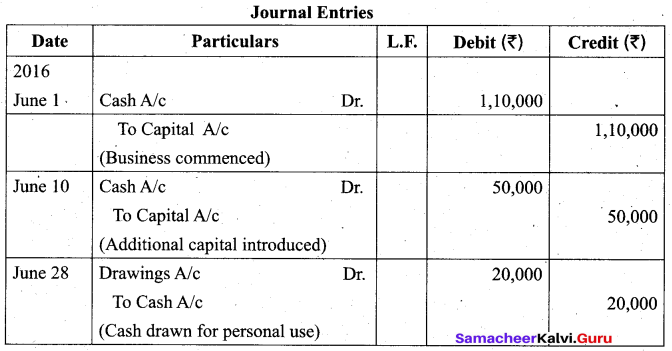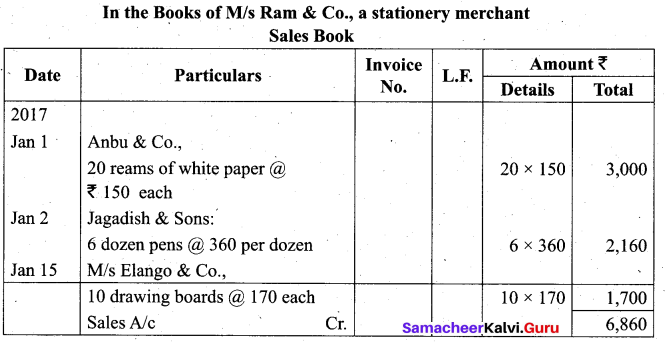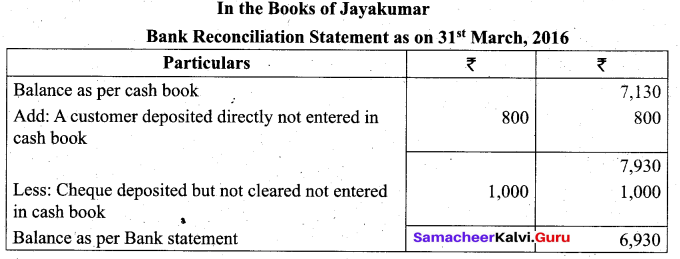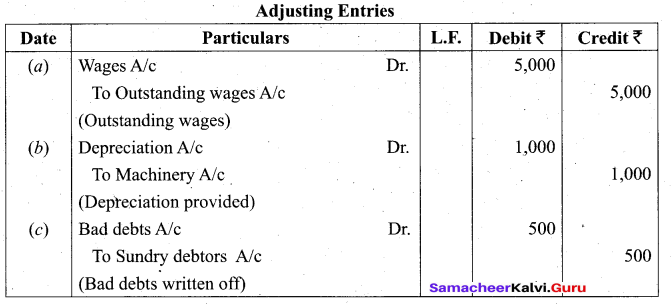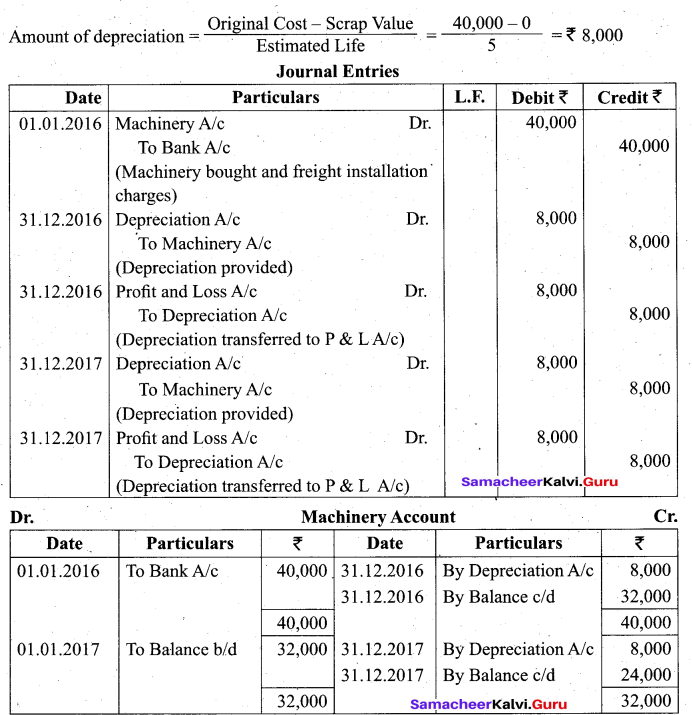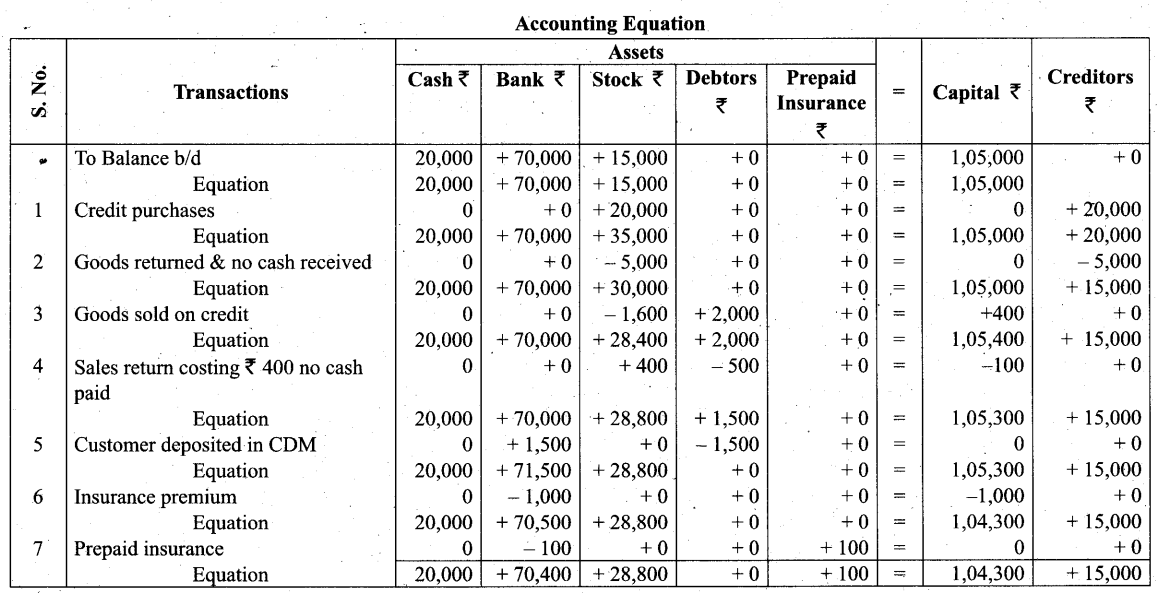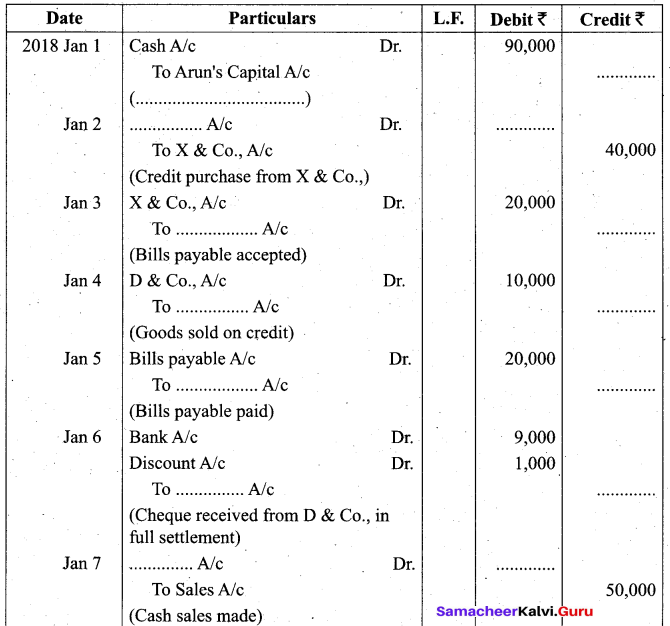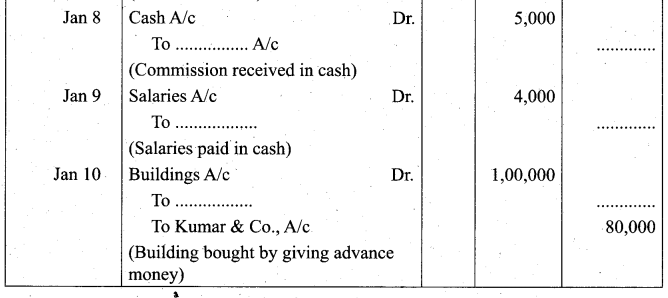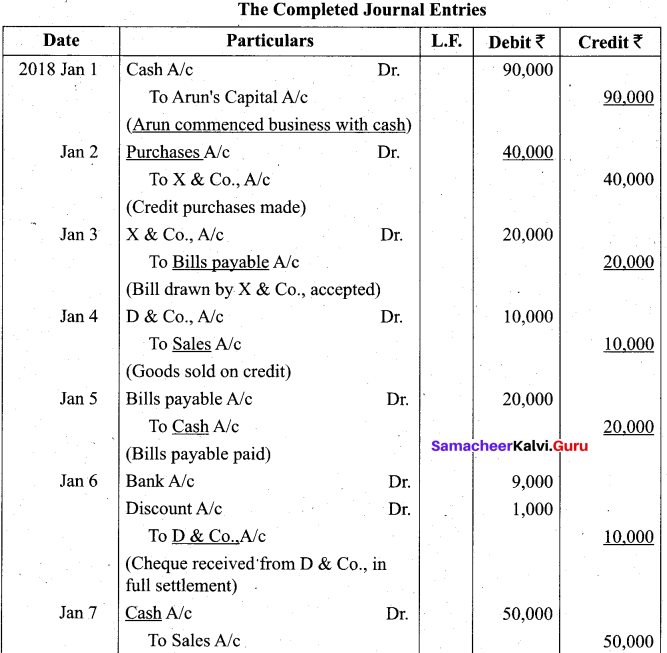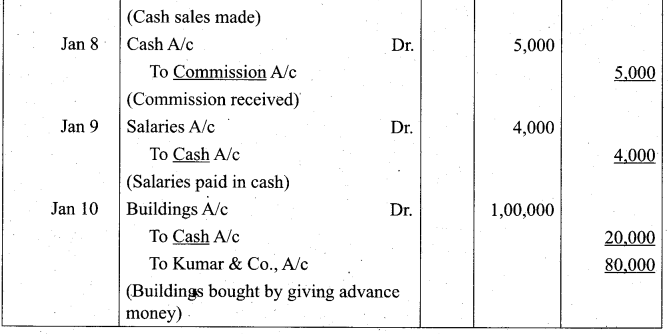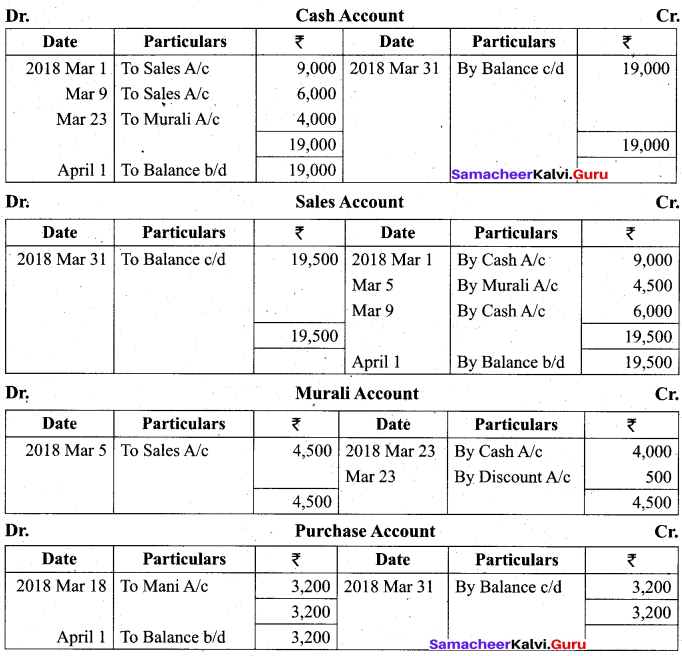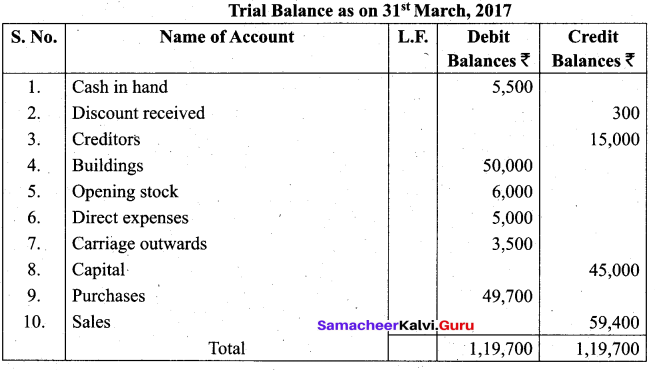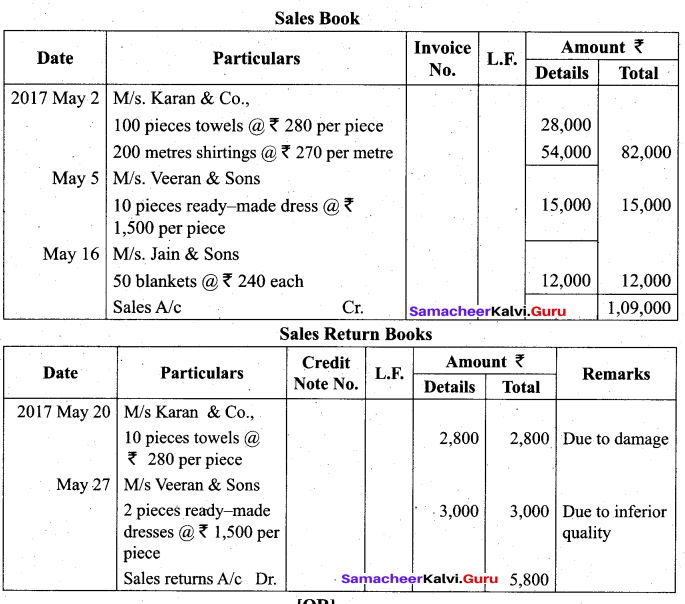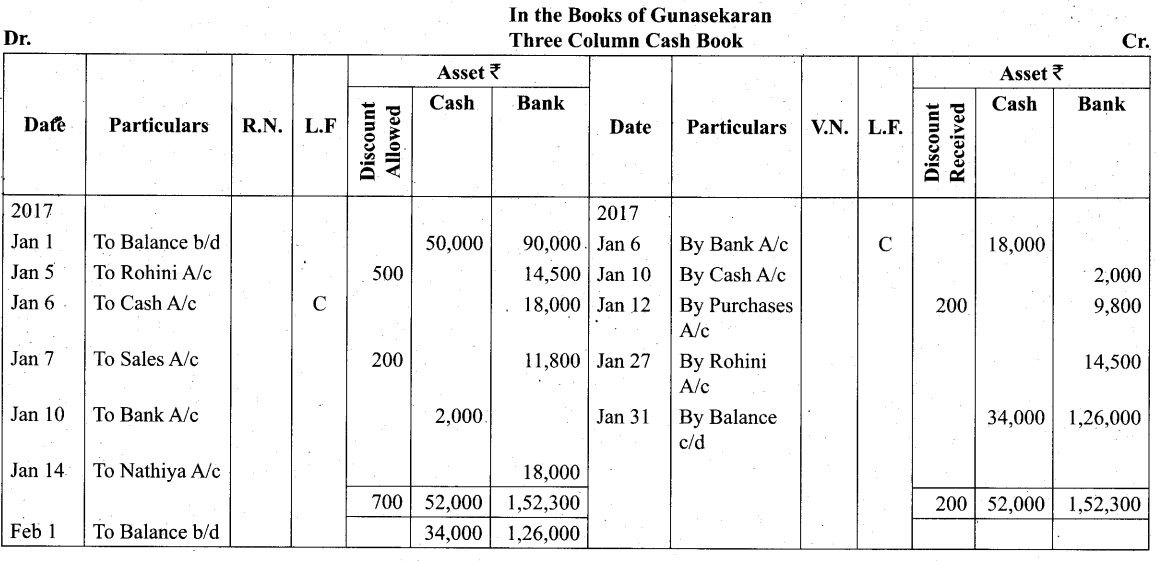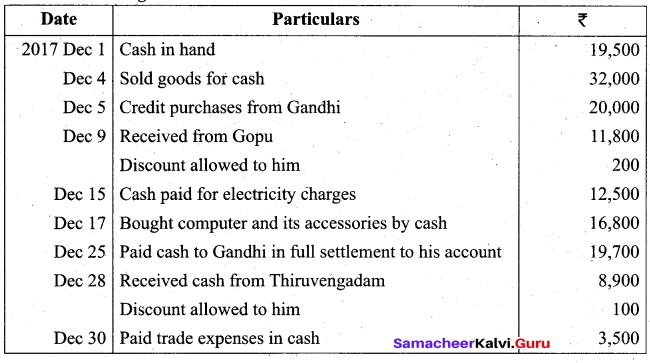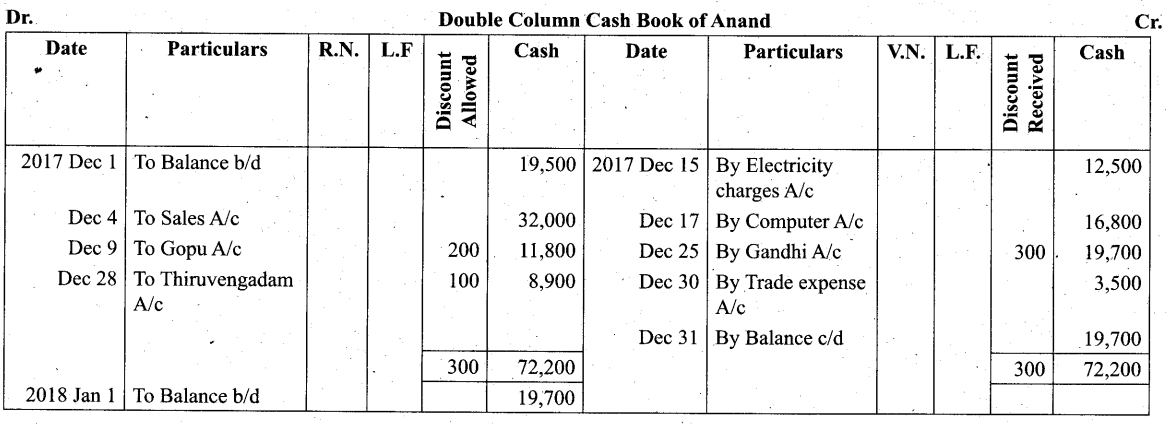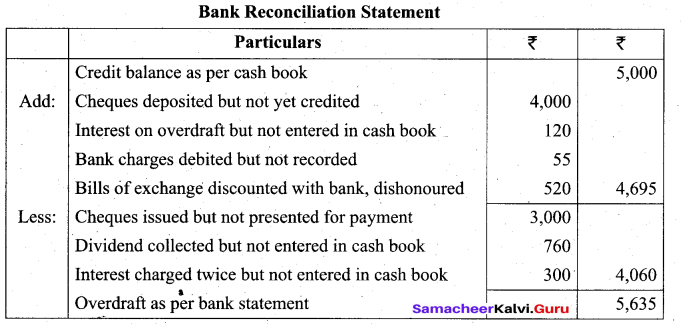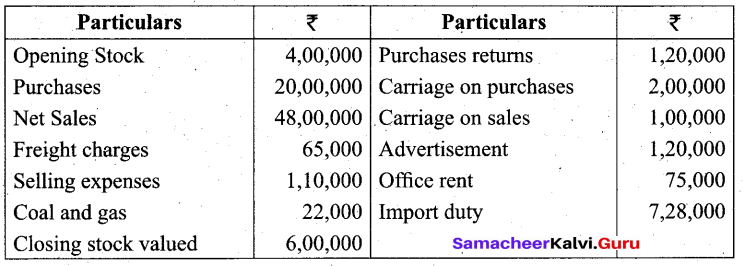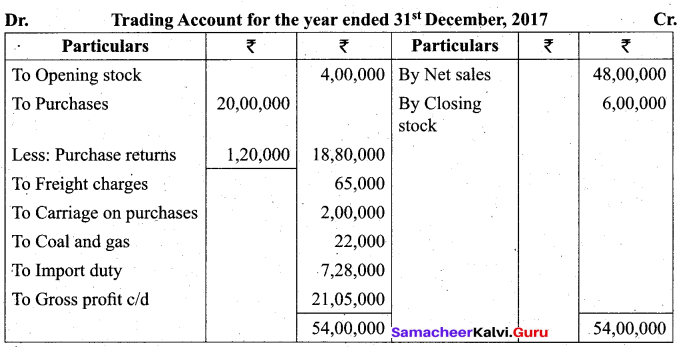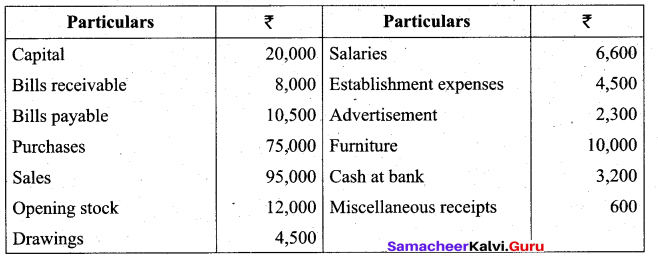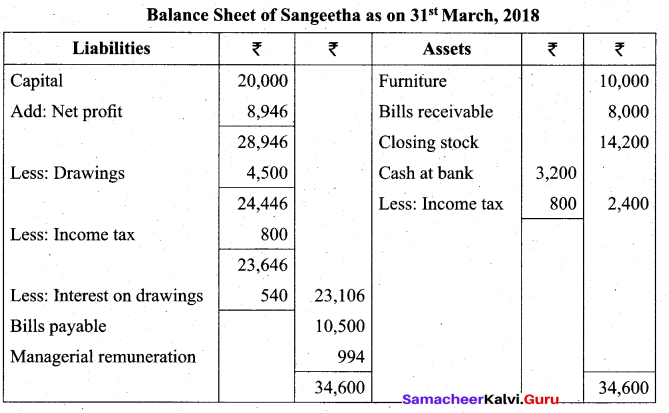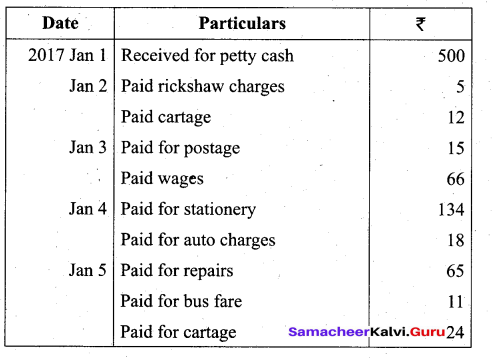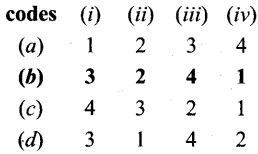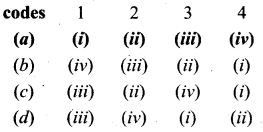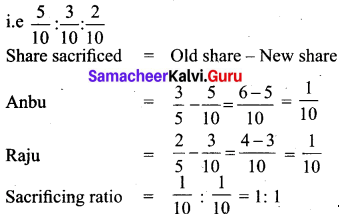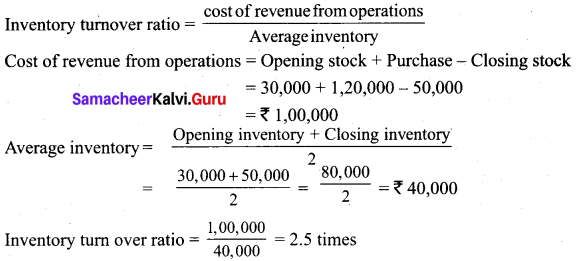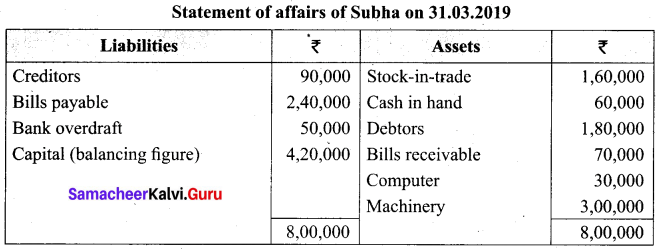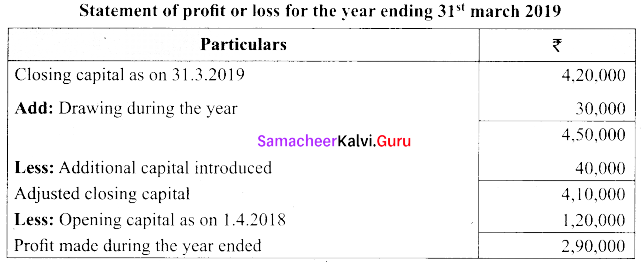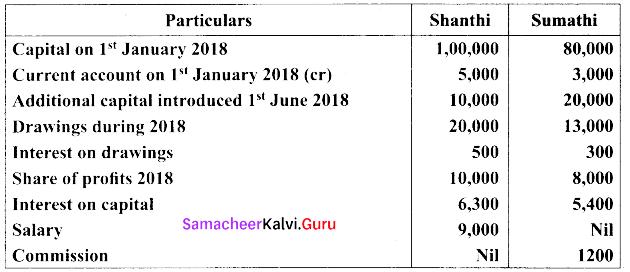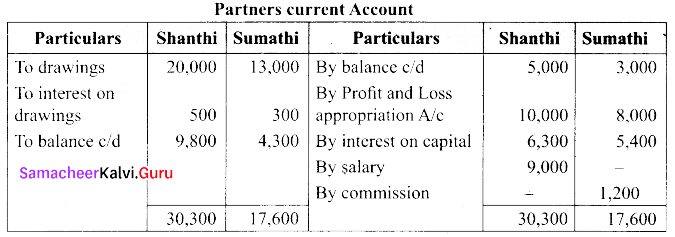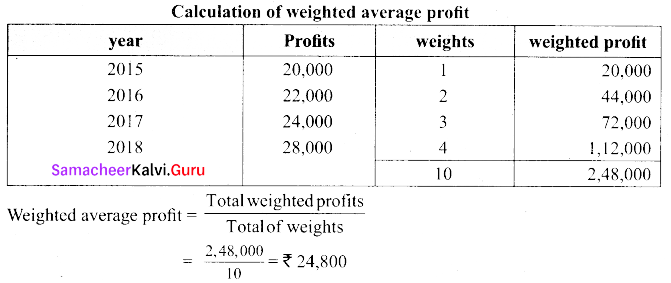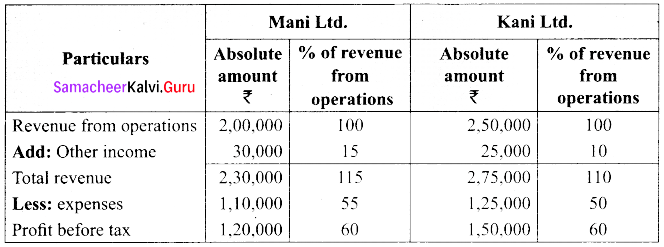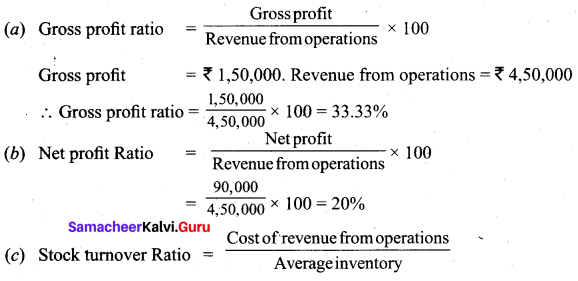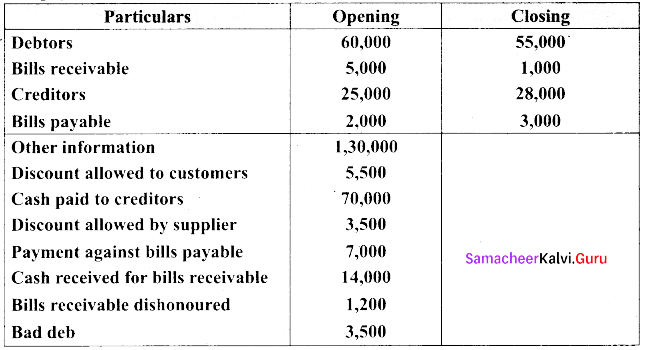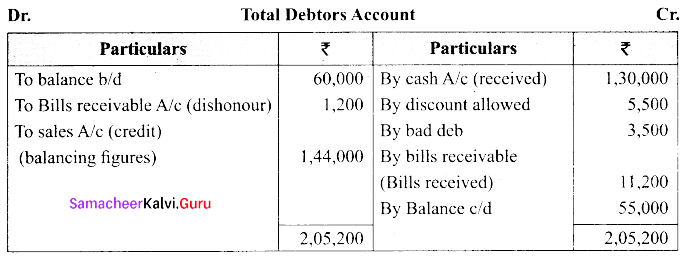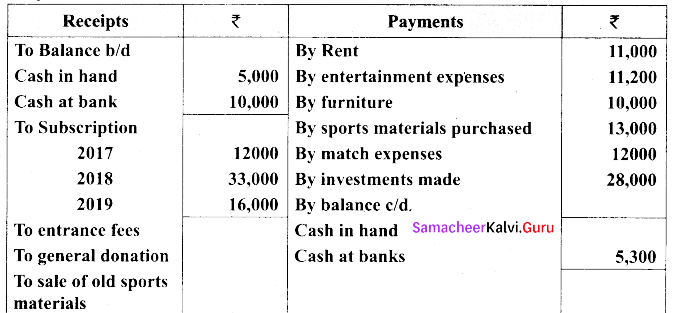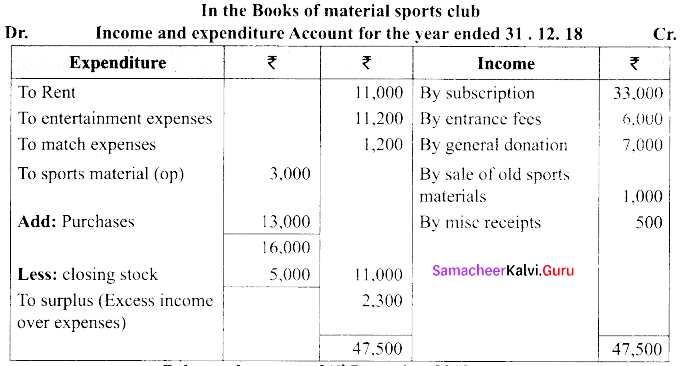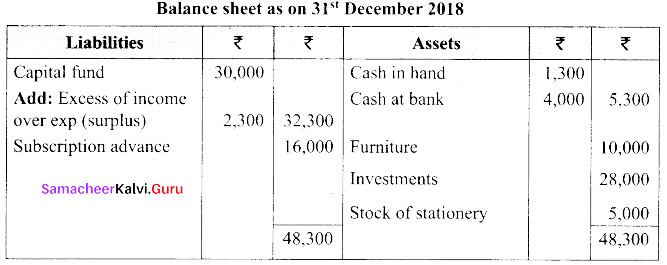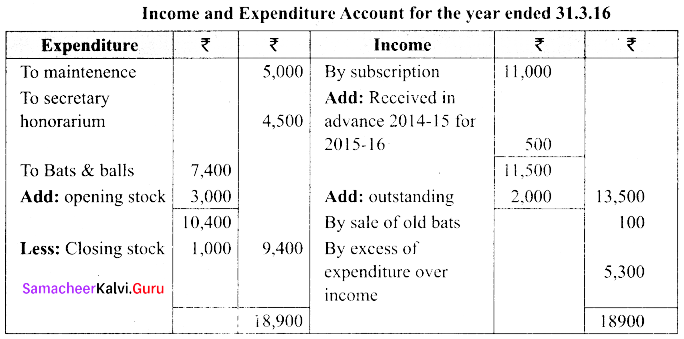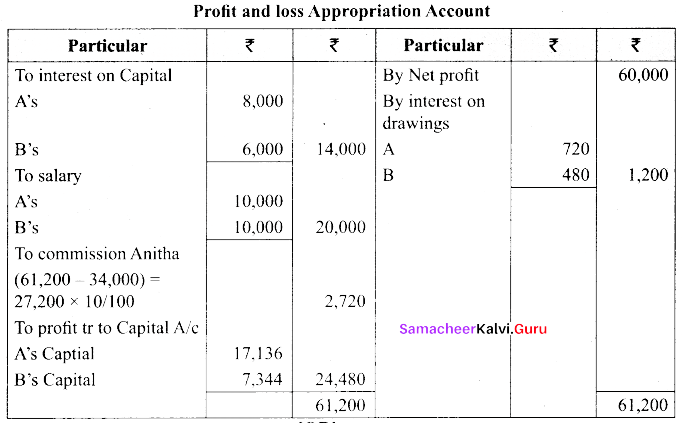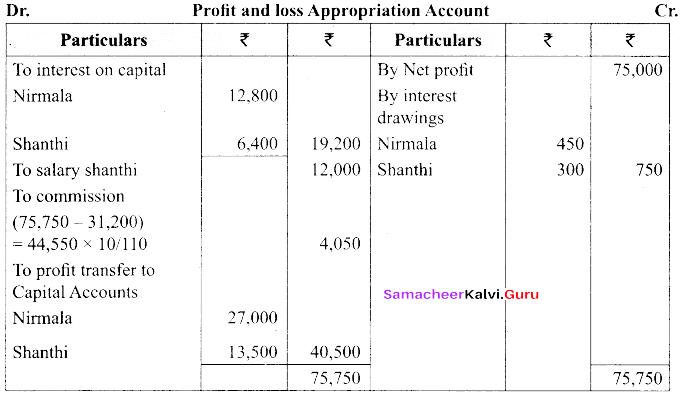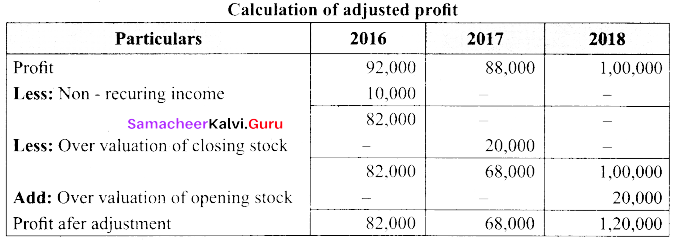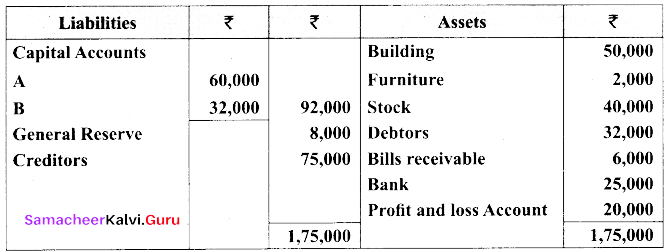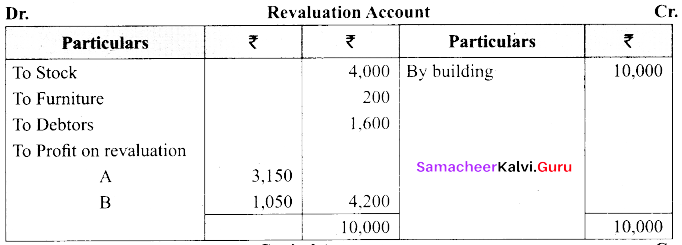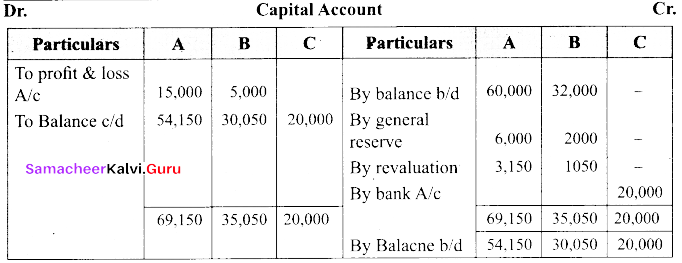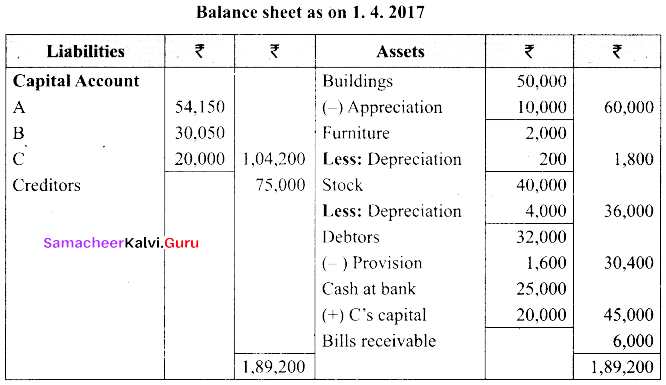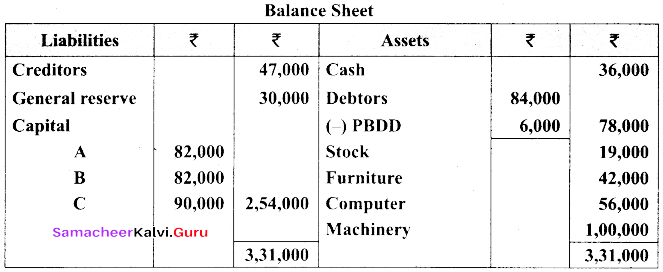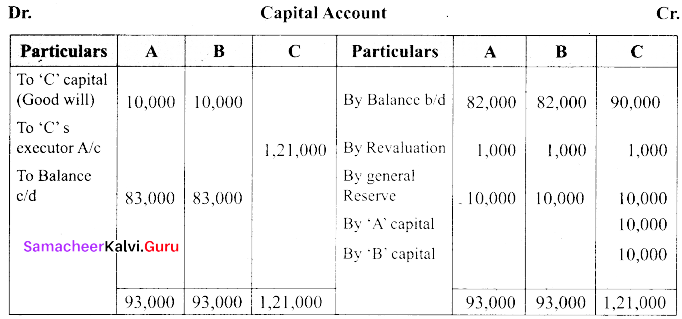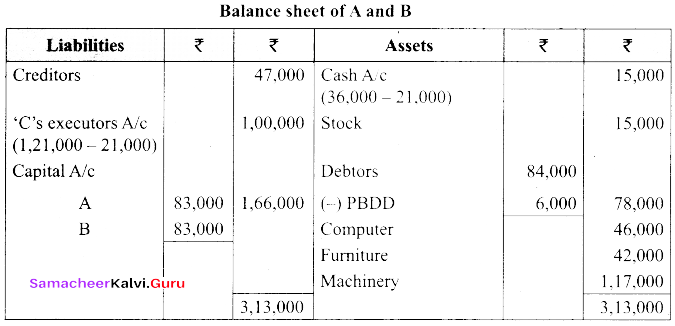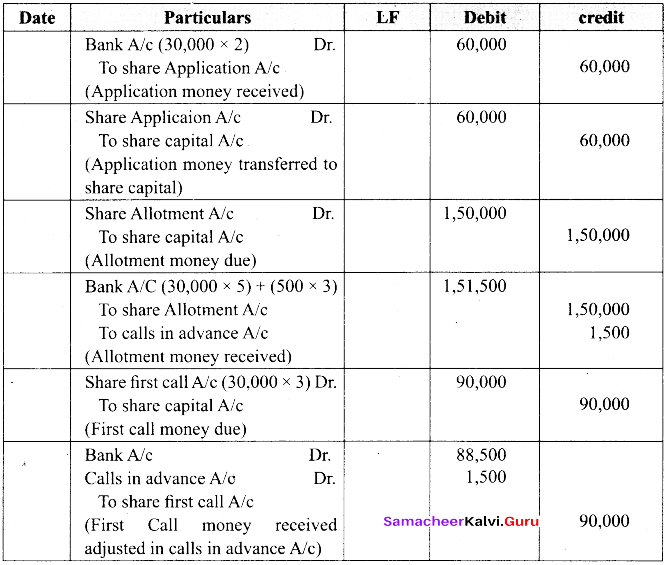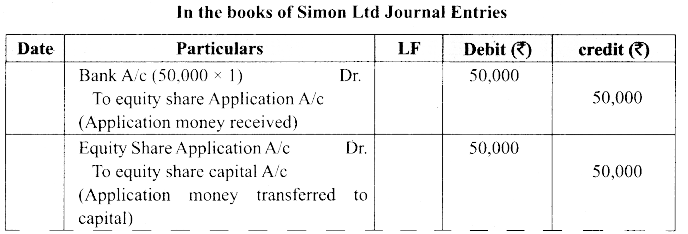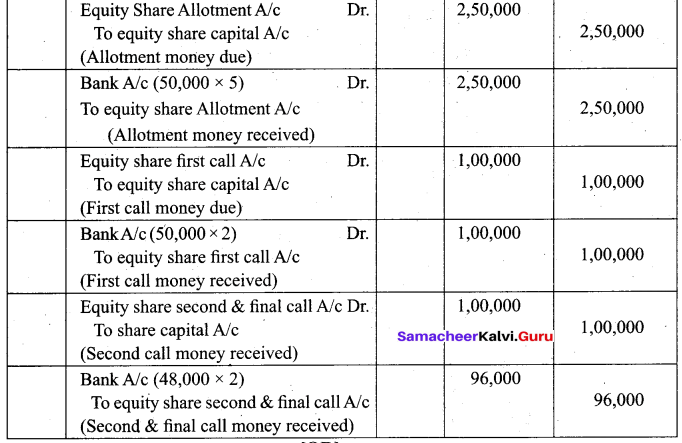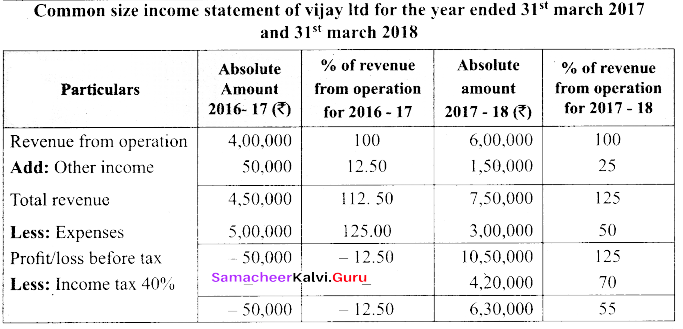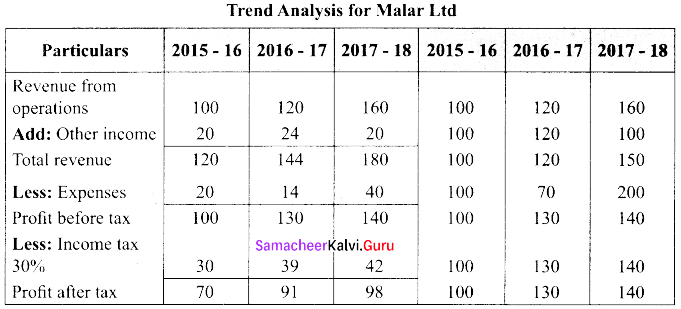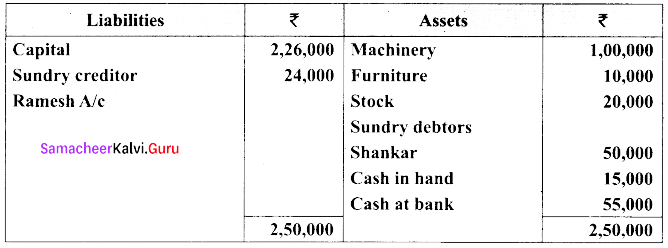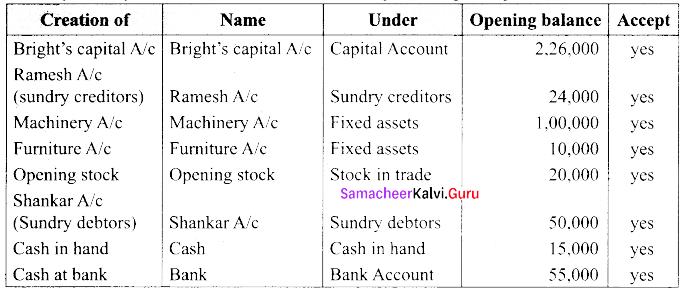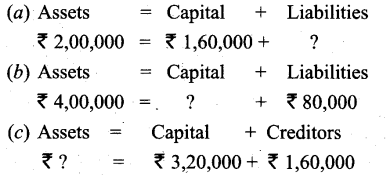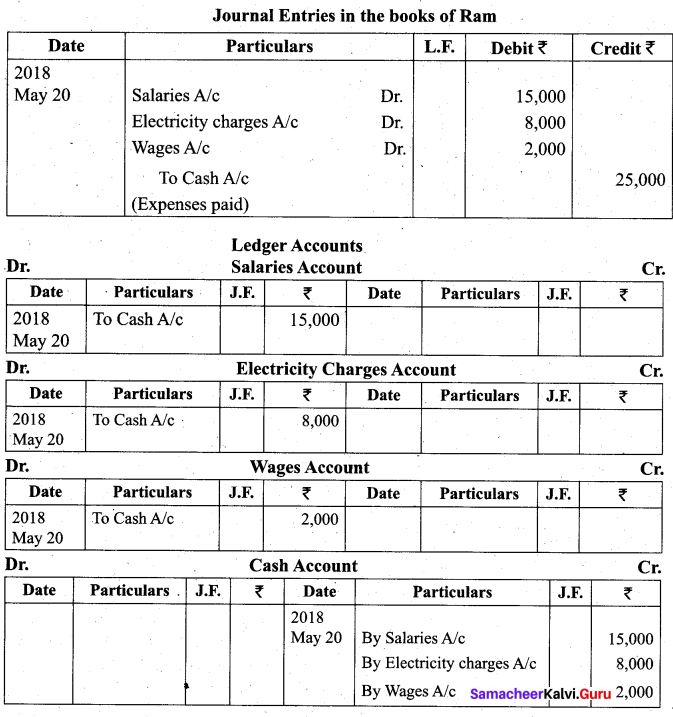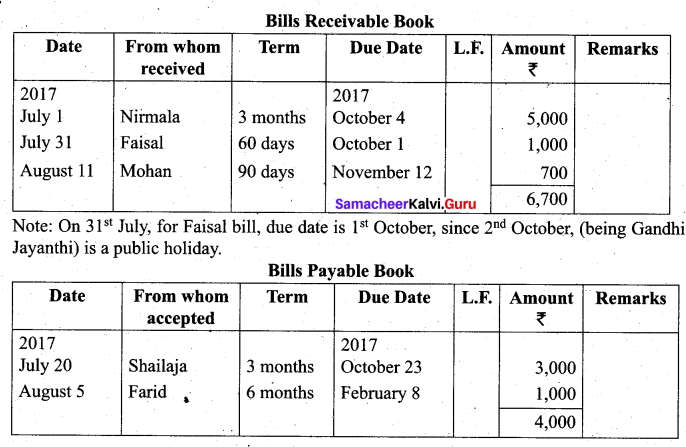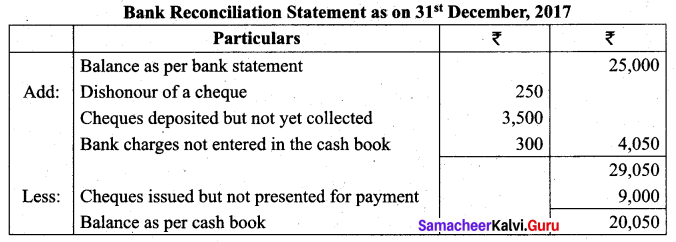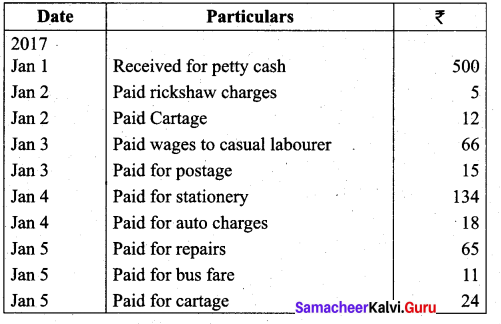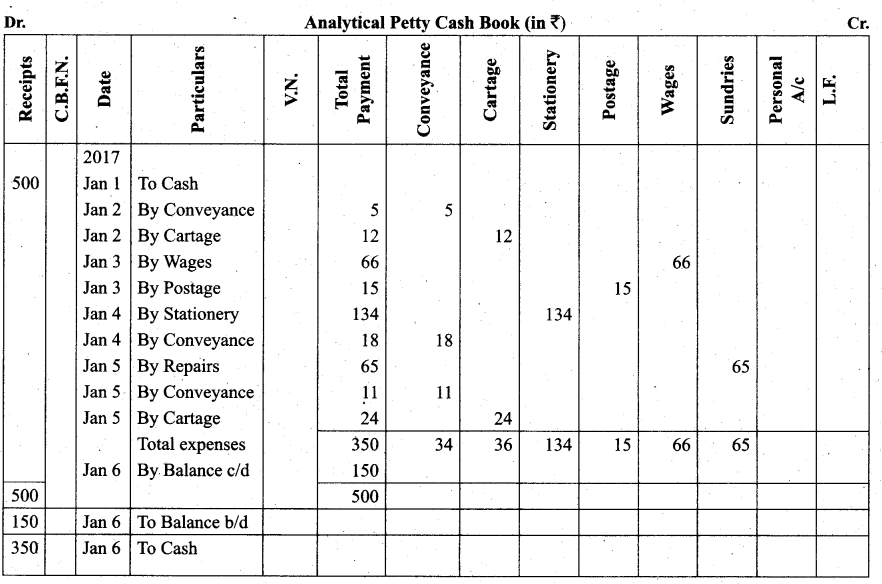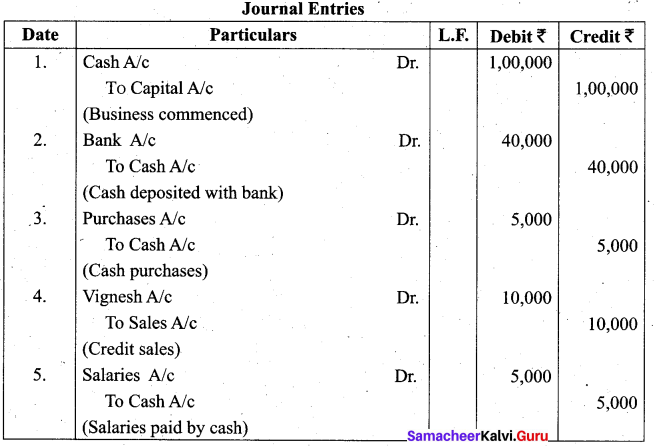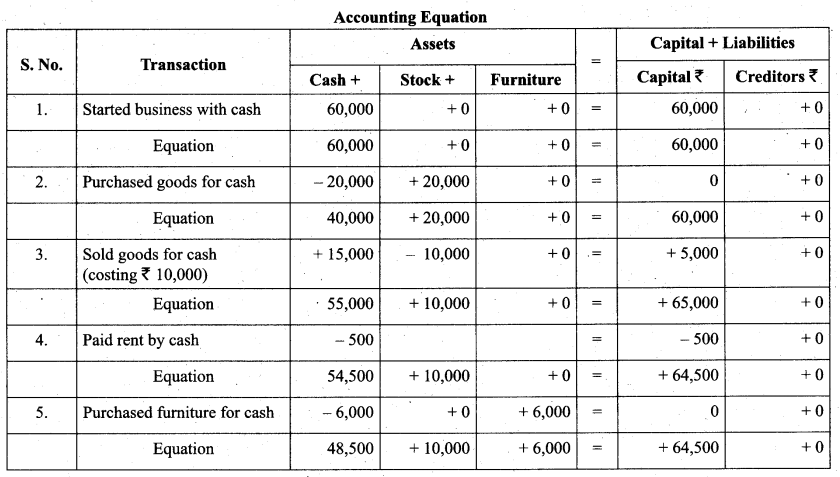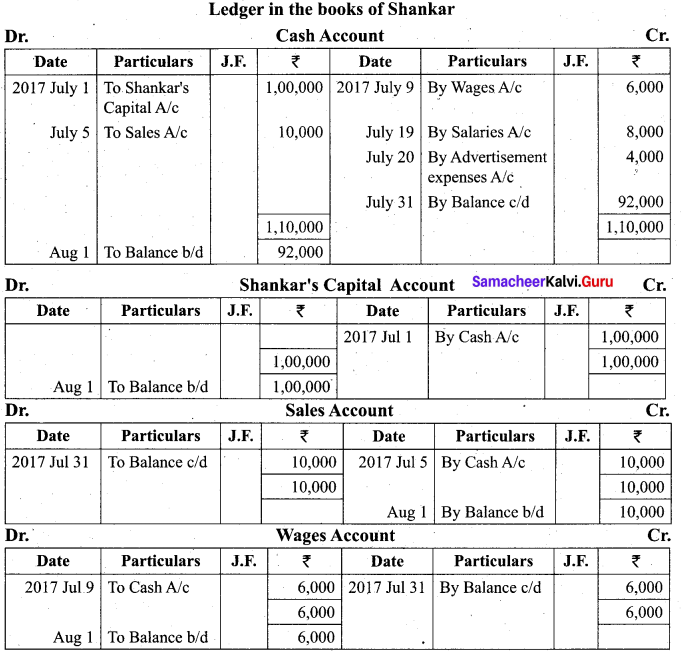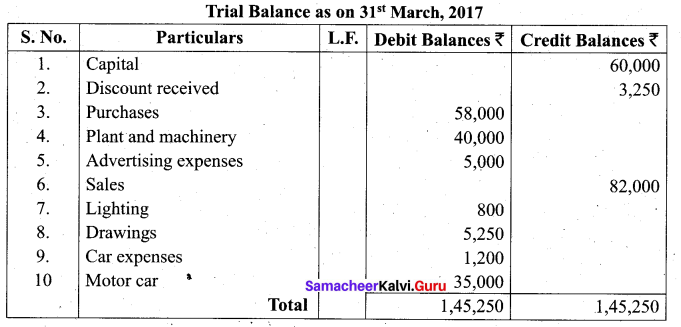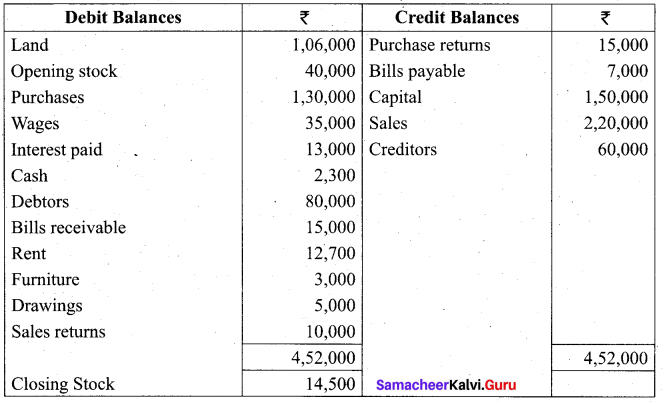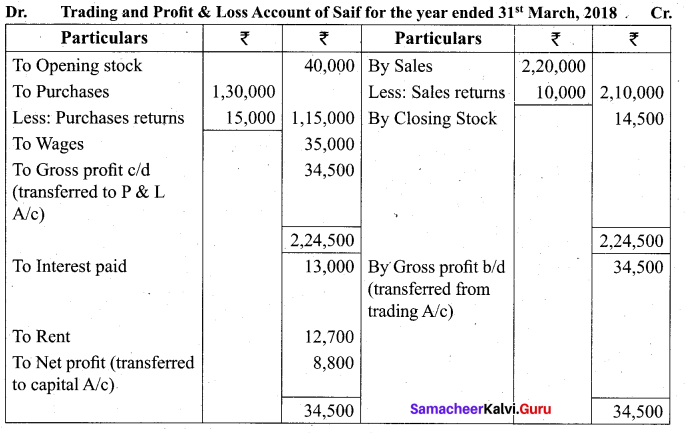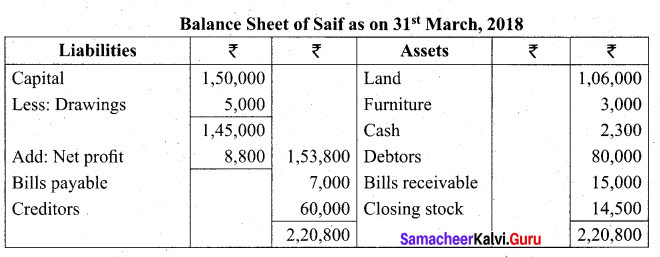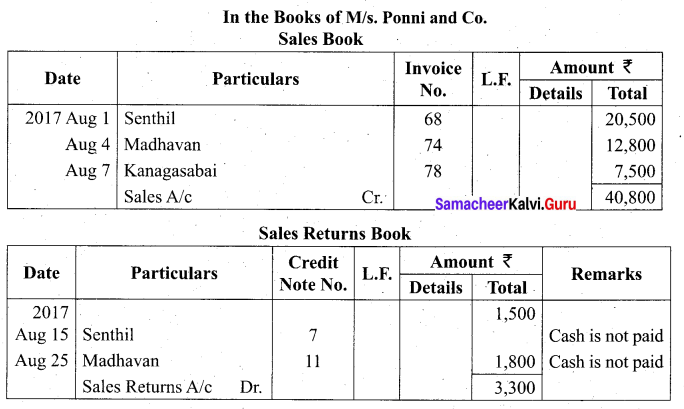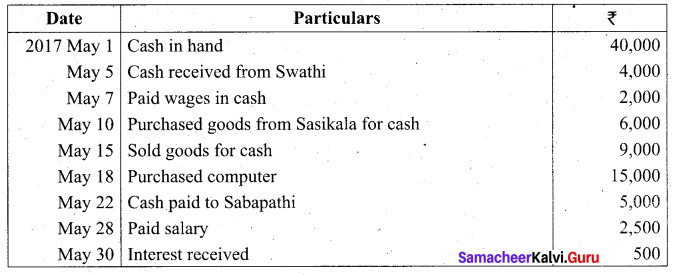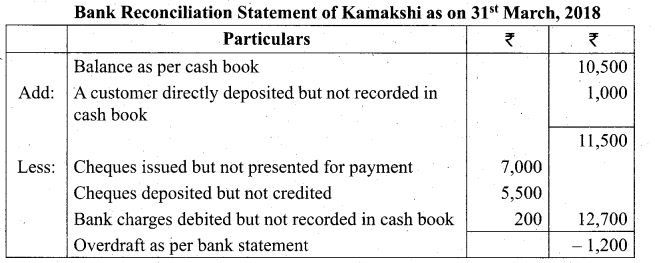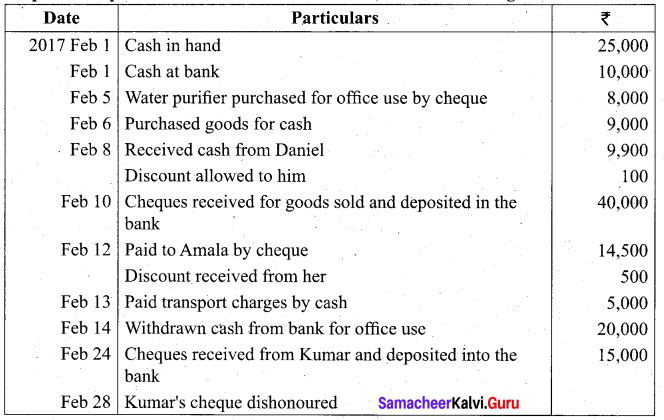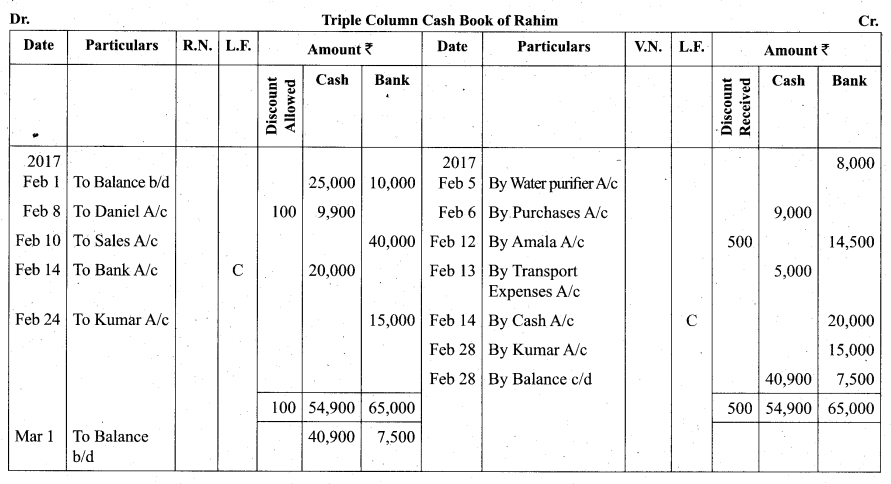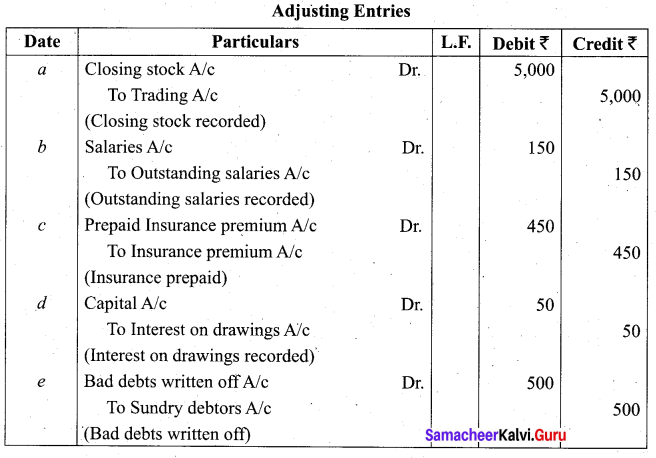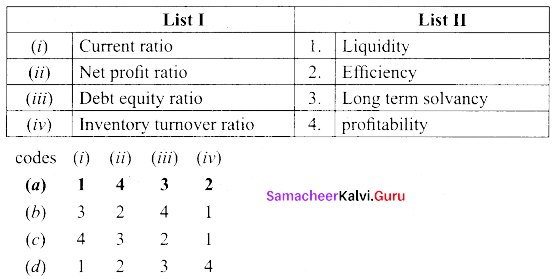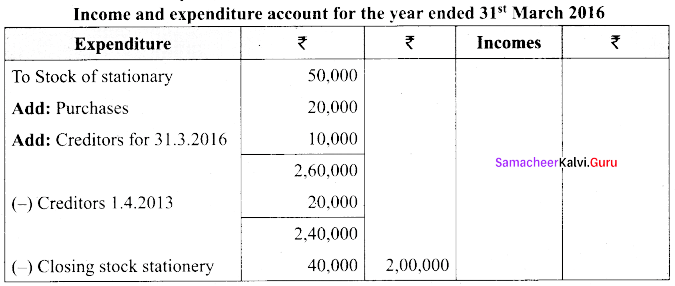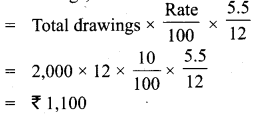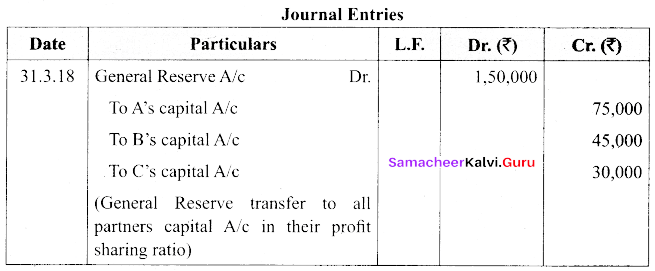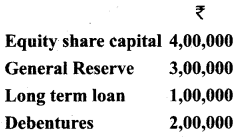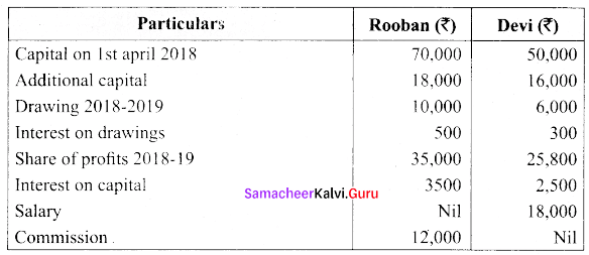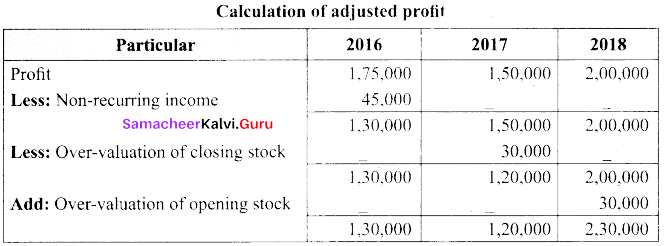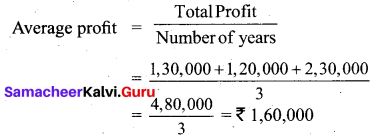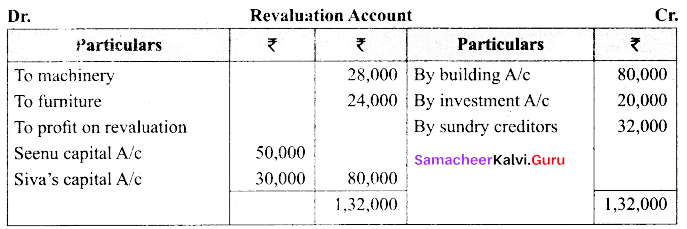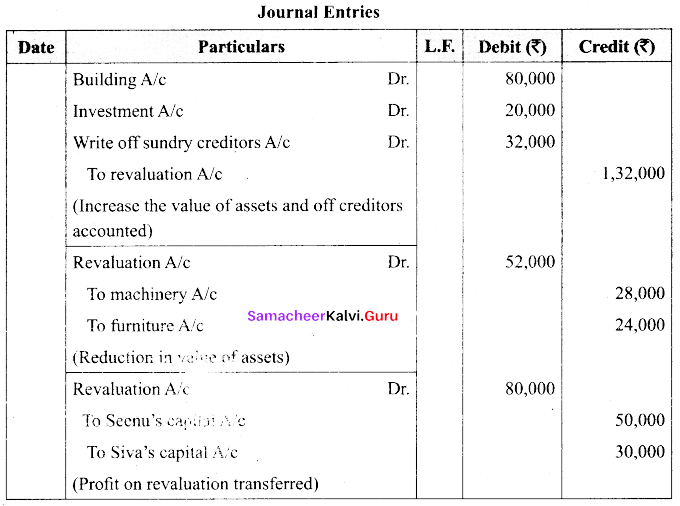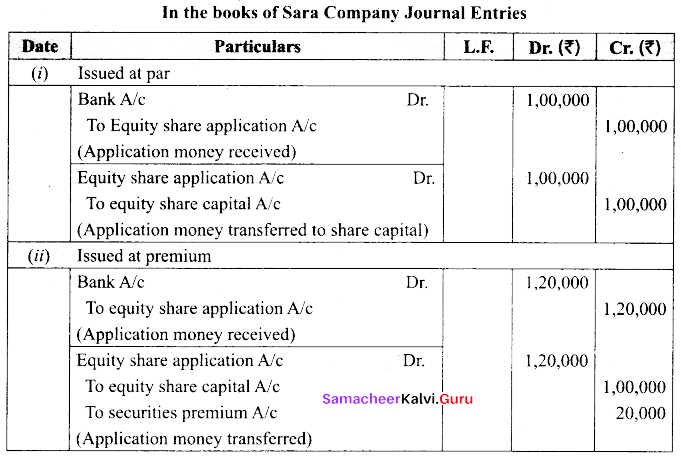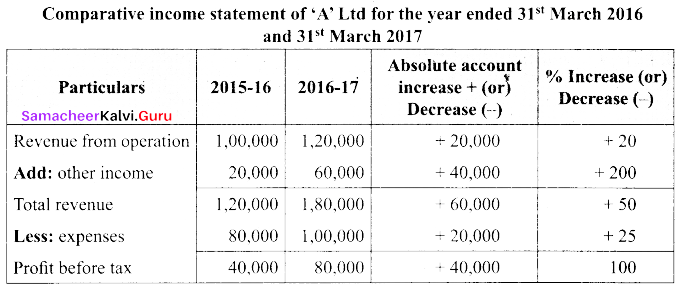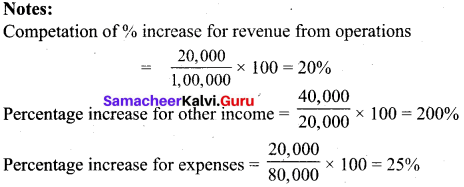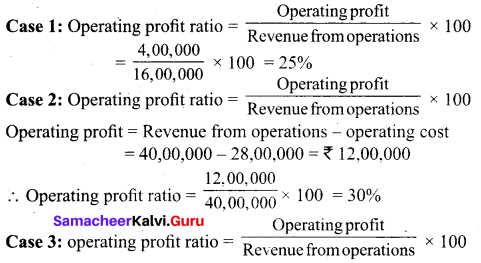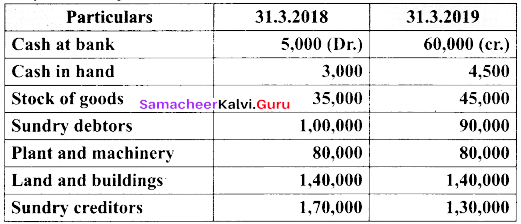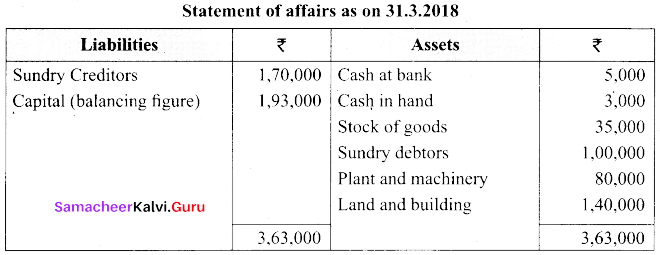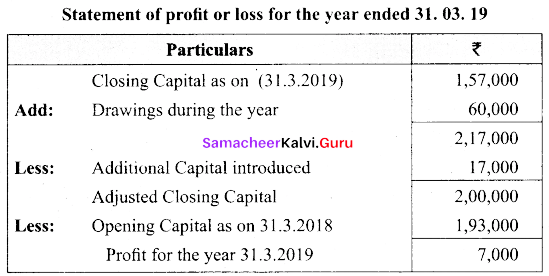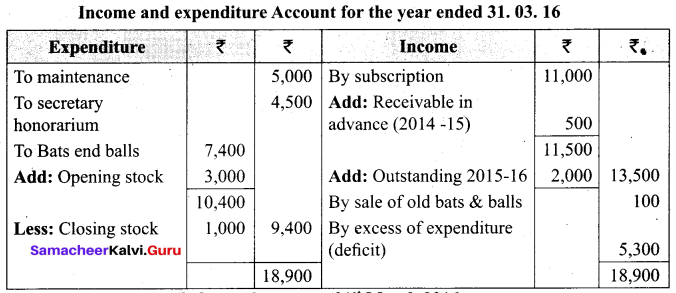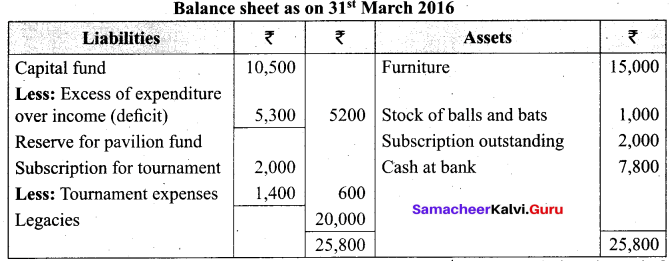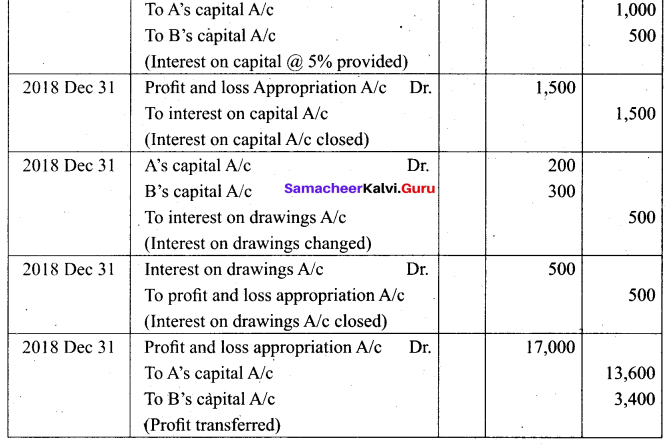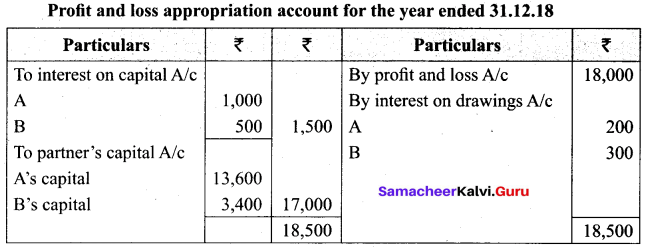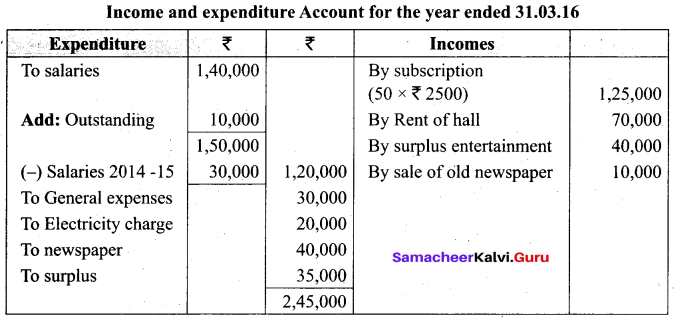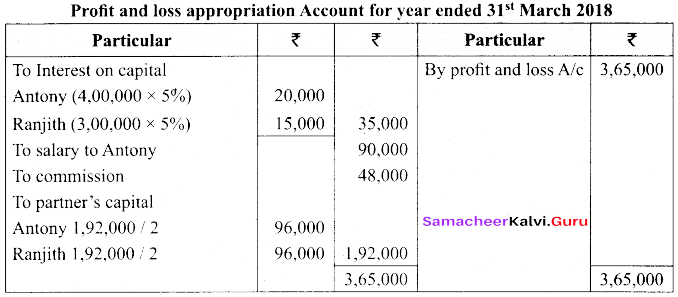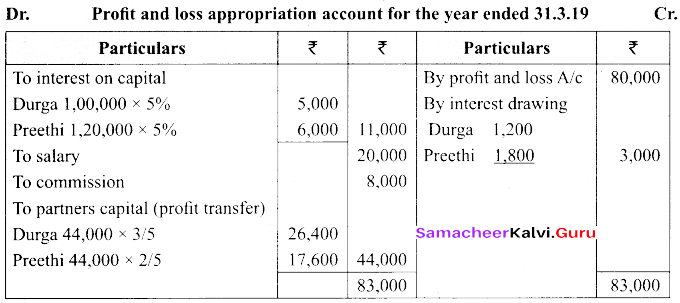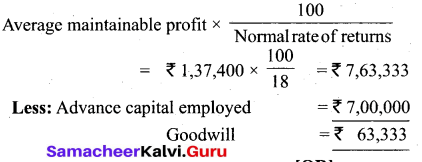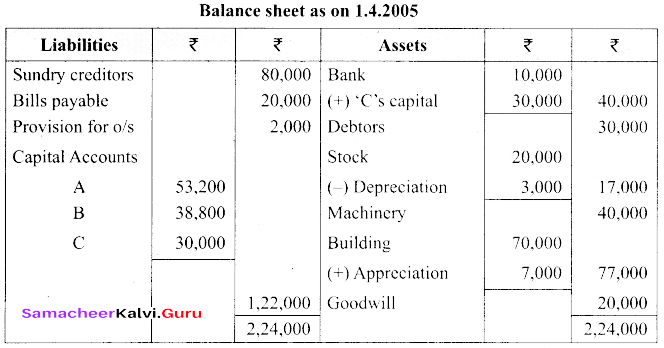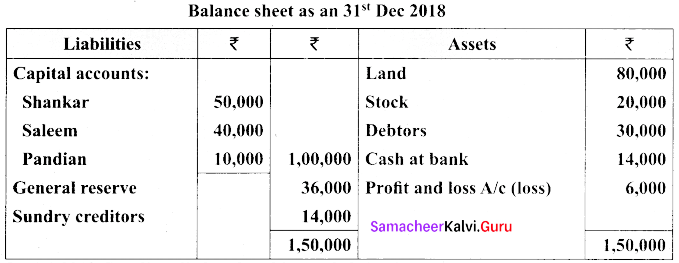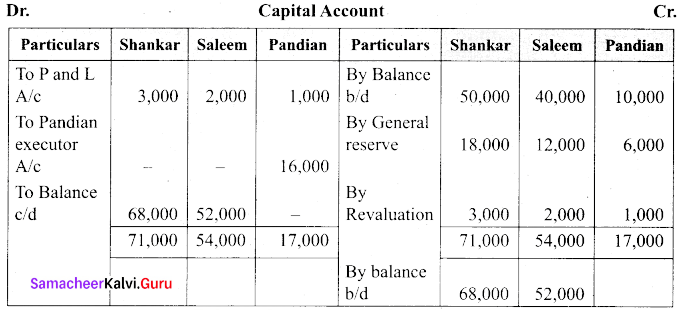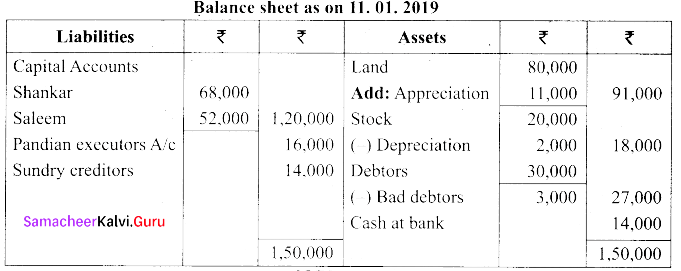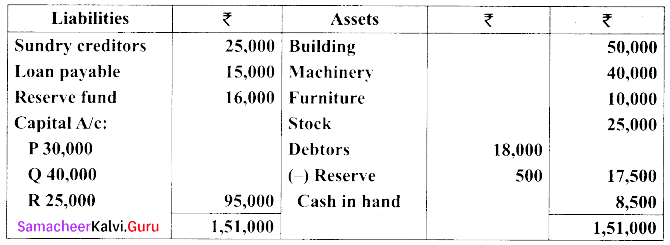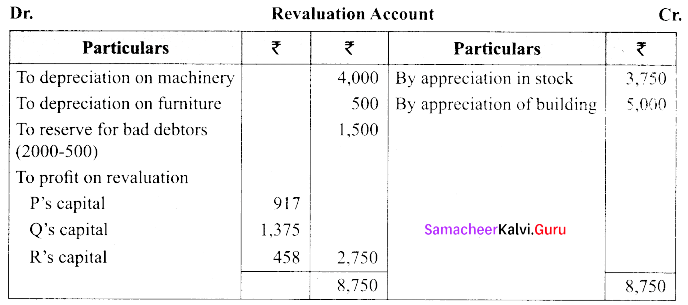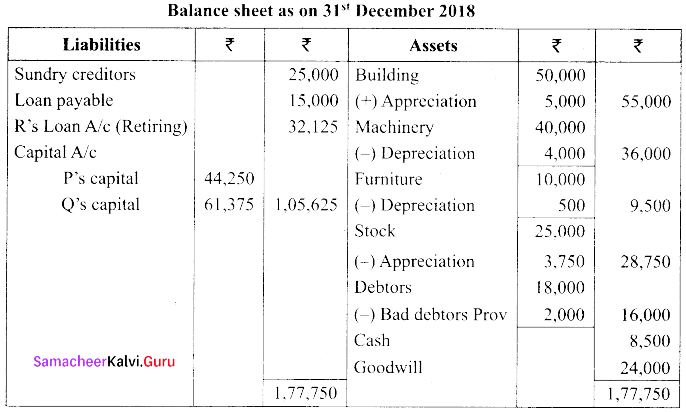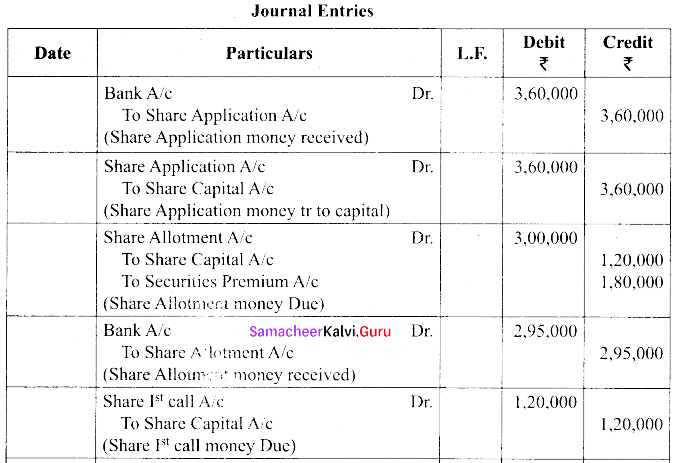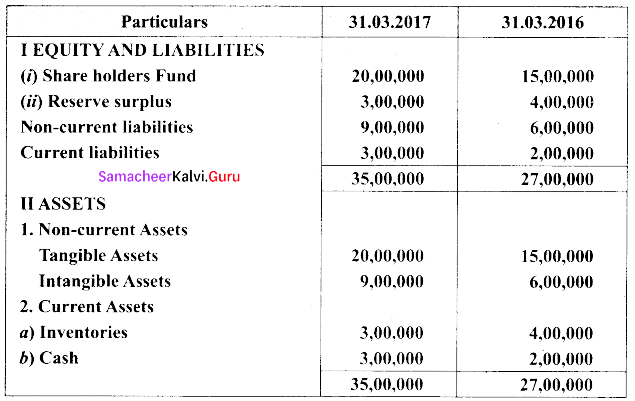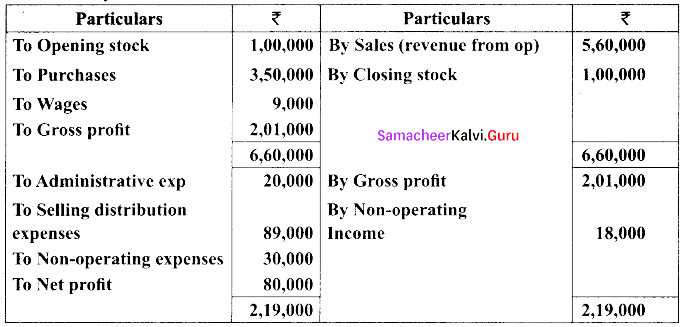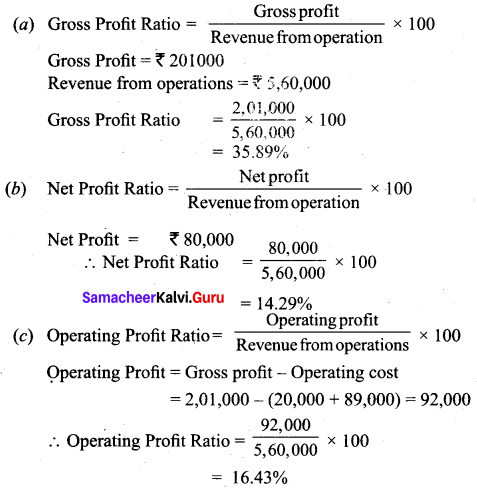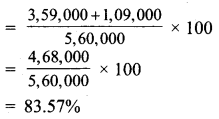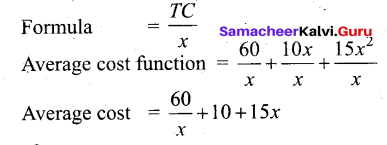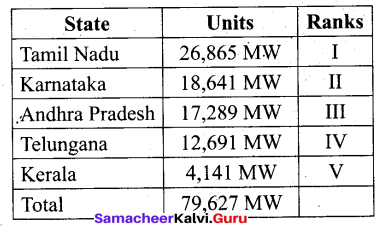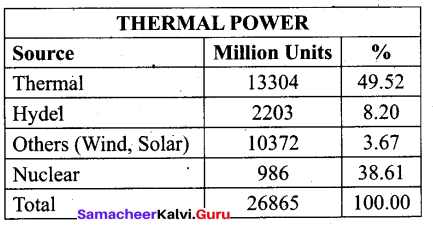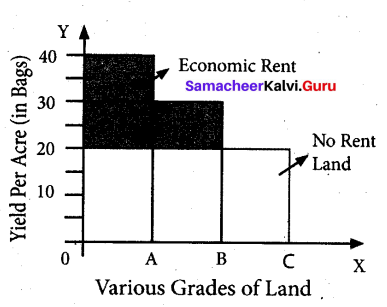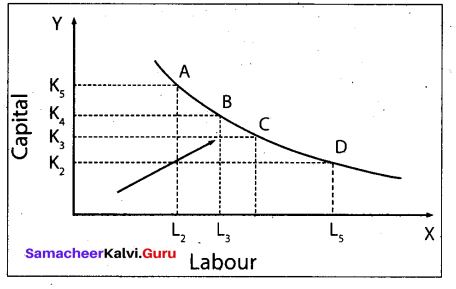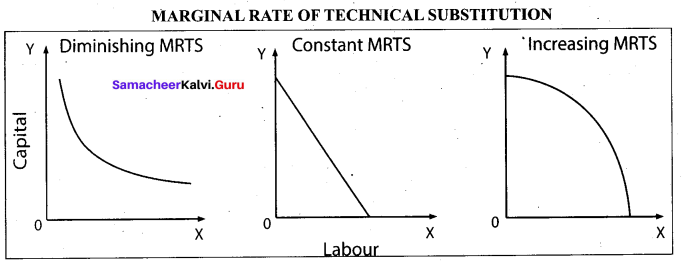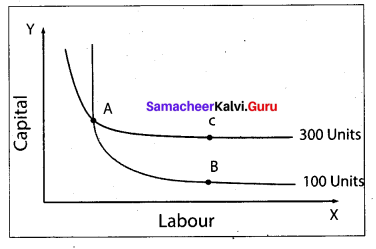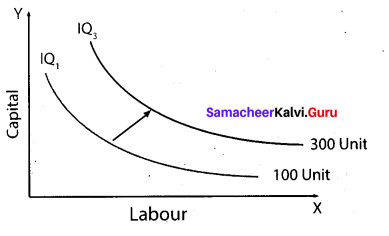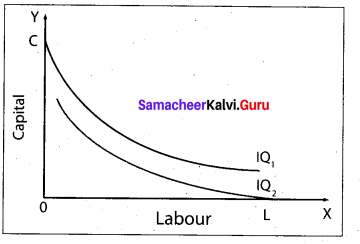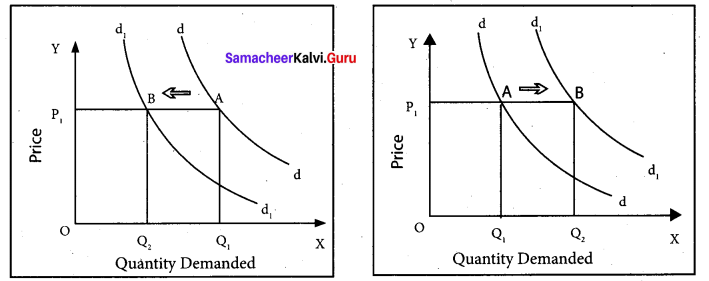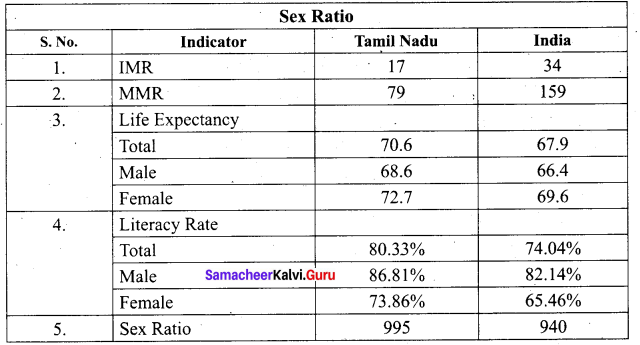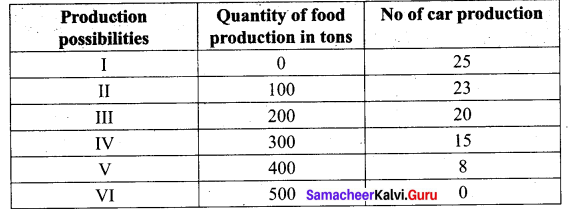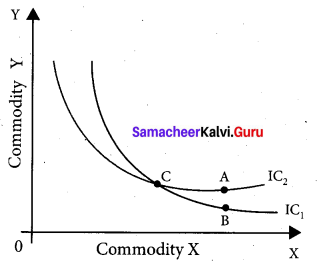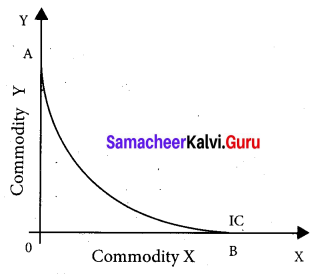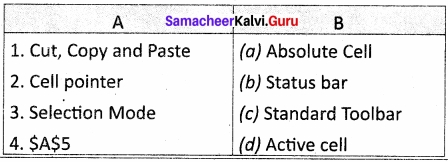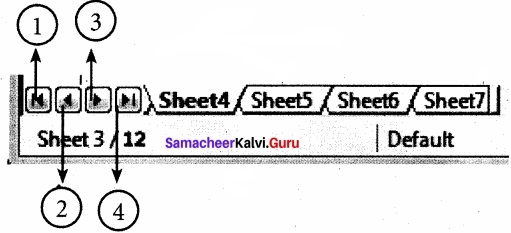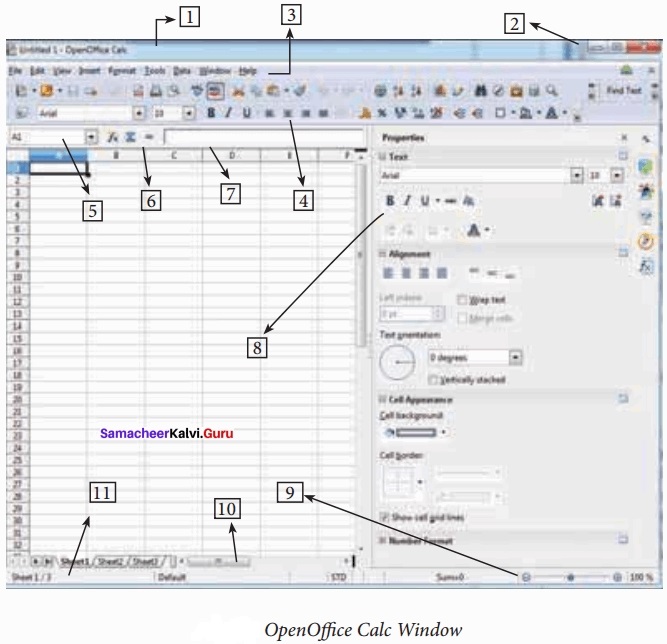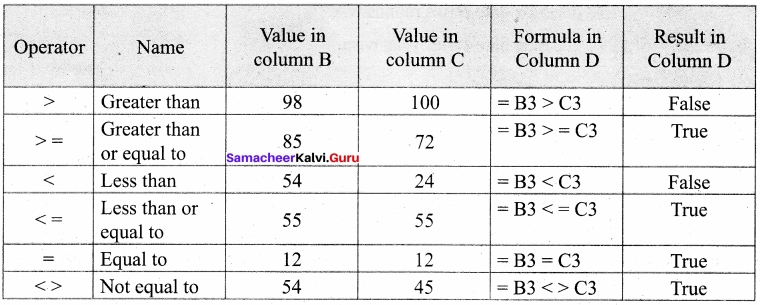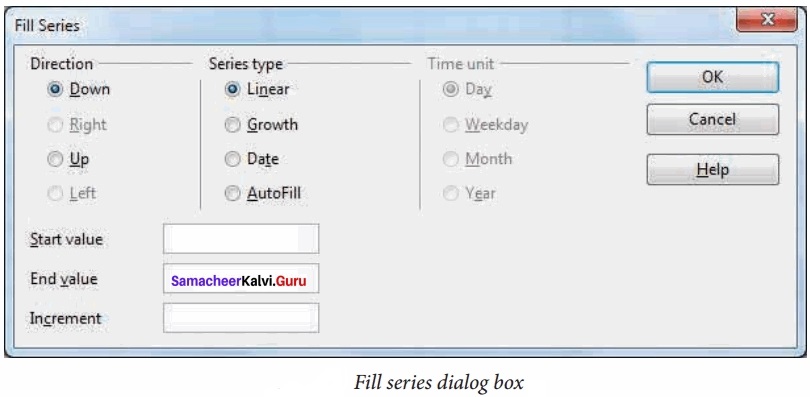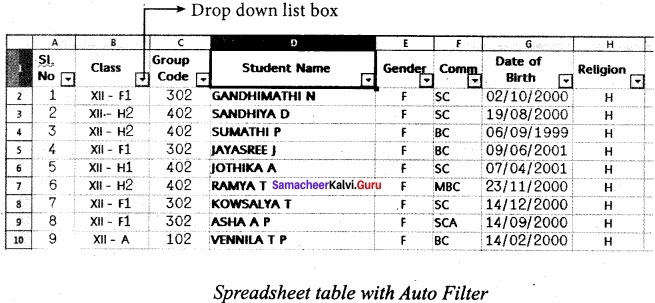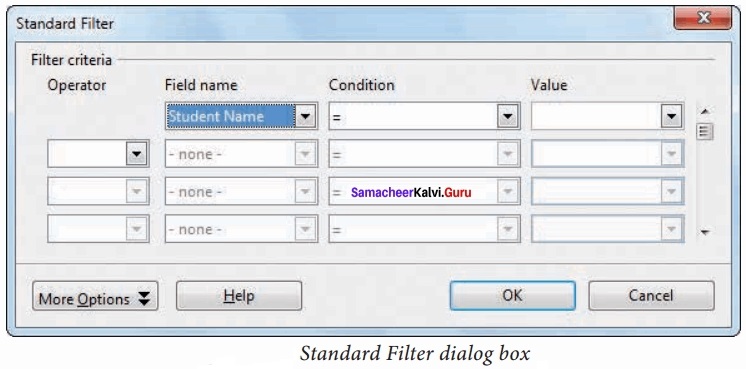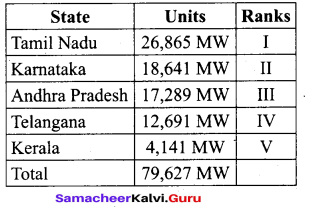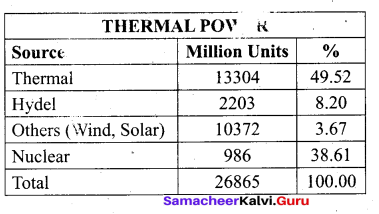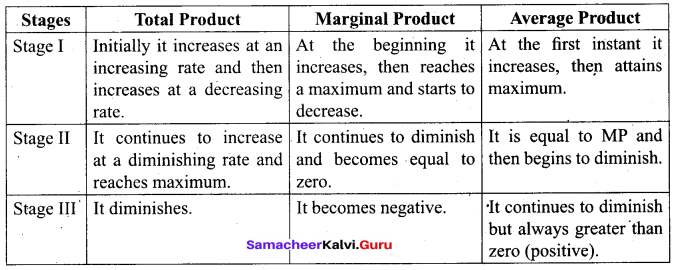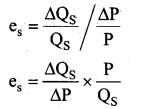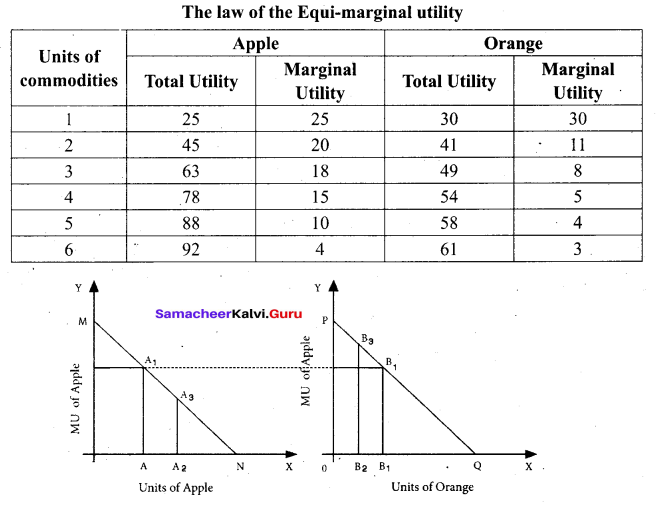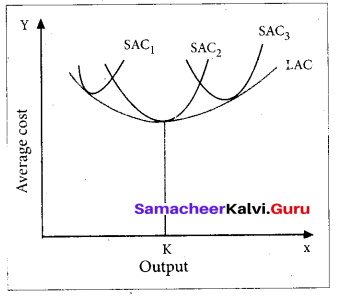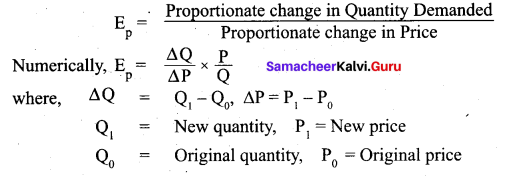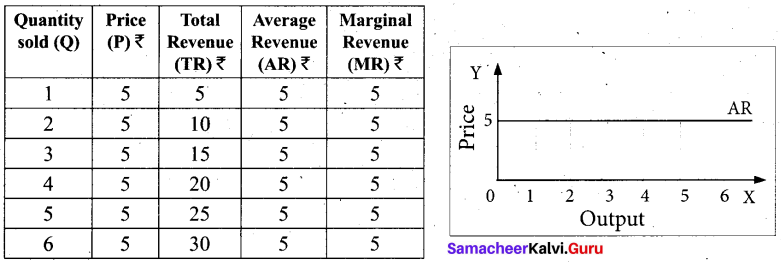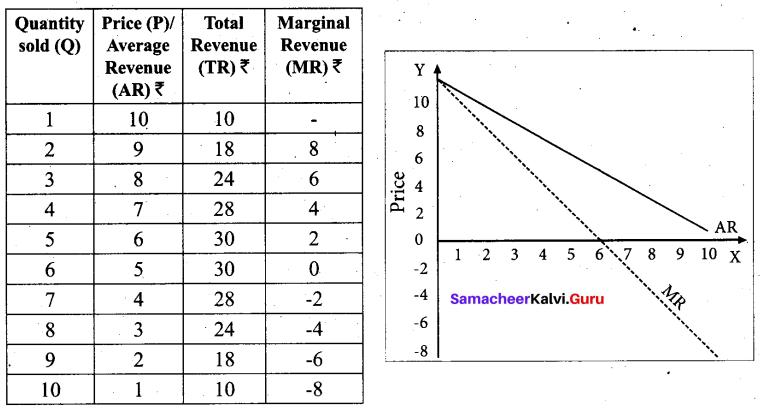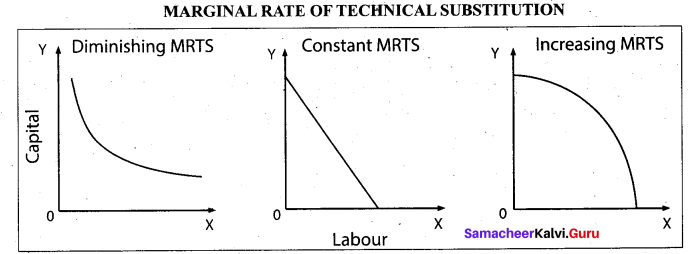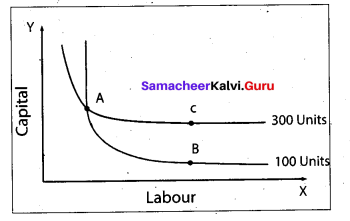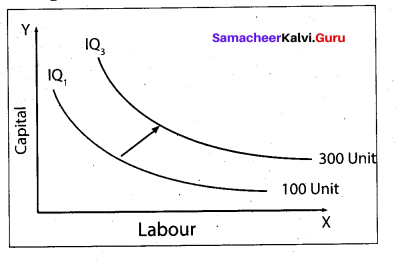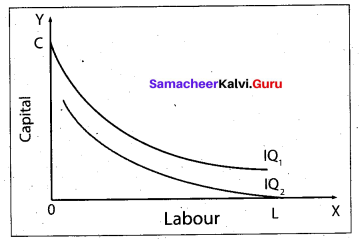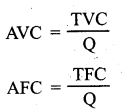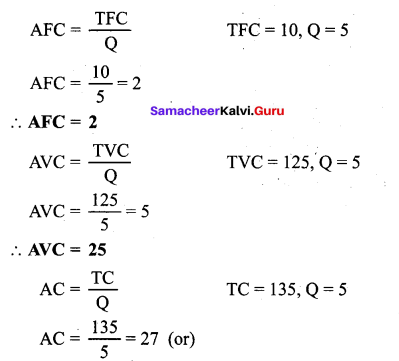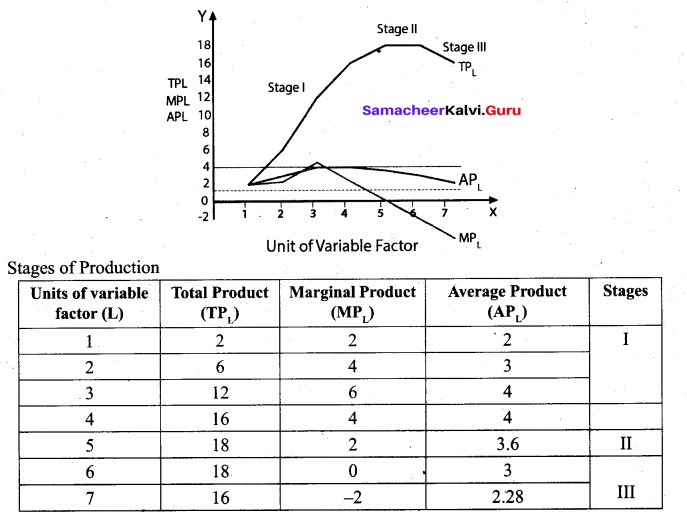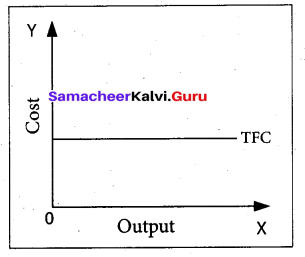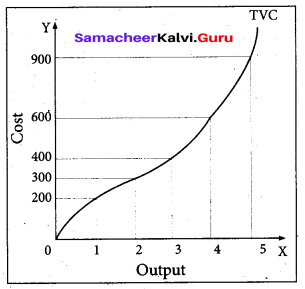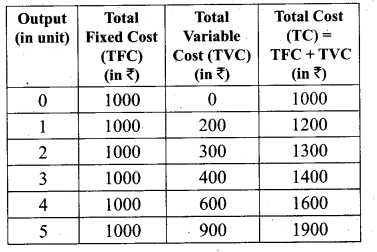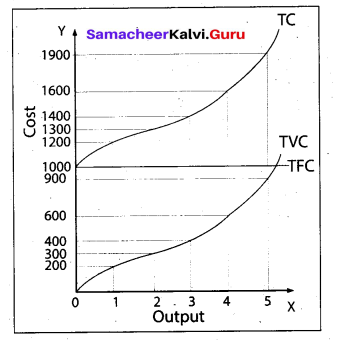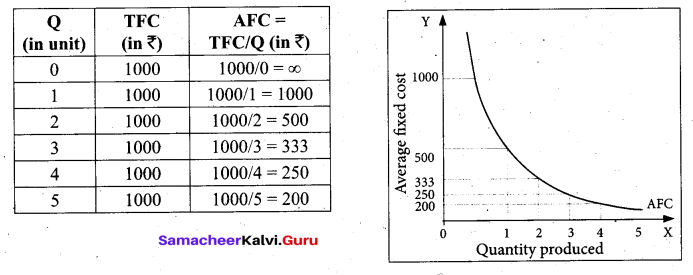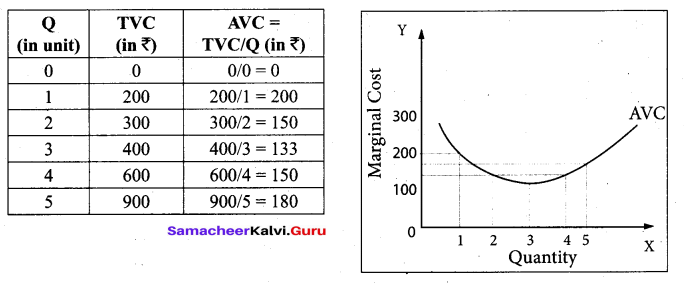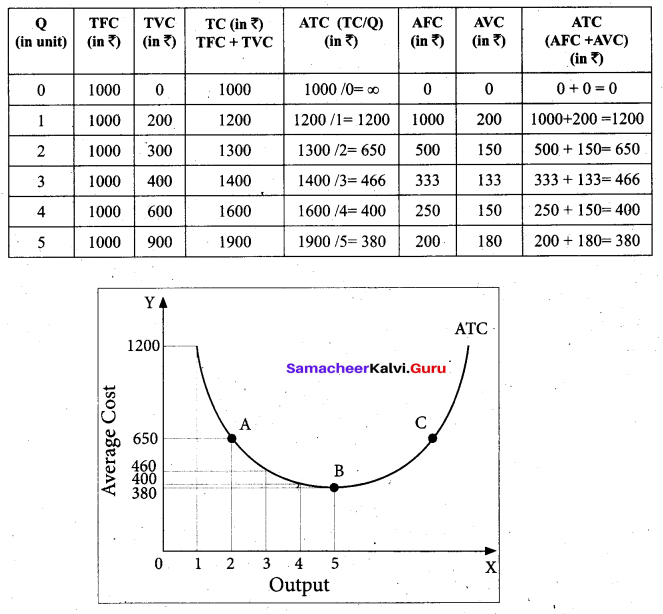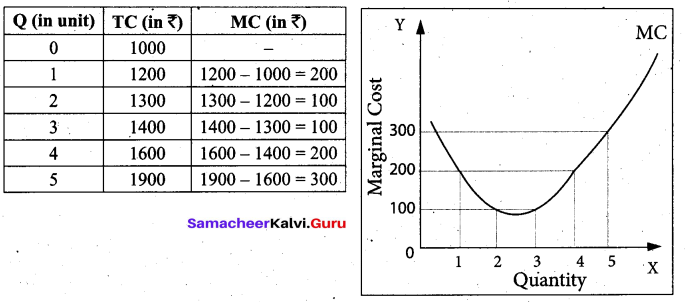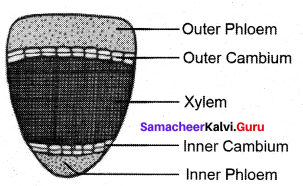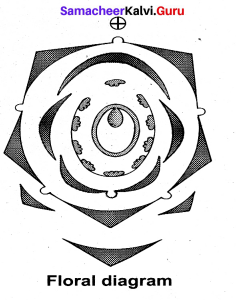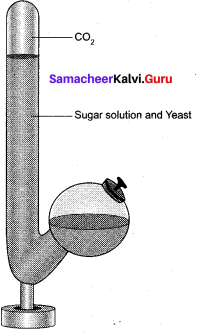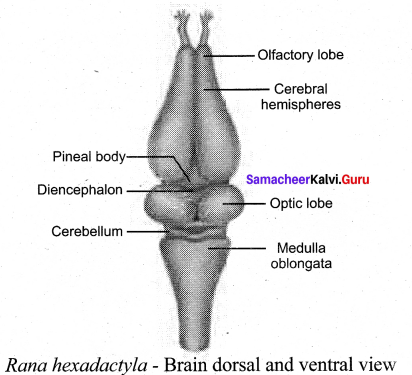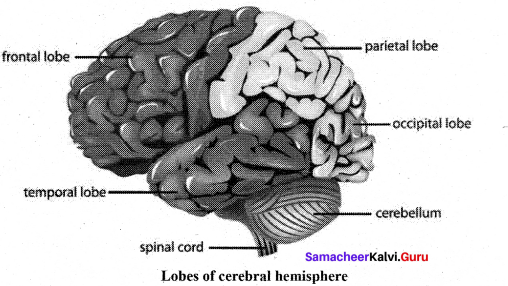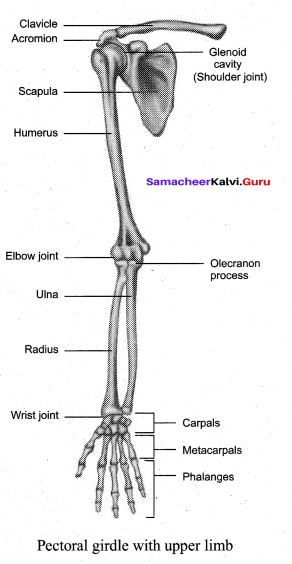Students can Download Tamil Nadu 11th Accountancy Model Question Paper 4 English Medium Pdf, Tamil Nadu 11th Accountancy Model Question Papers helps you to revise the complete Tamilnadu State Board New Syllabus and score more marks in your examinations.
TN State Board 11th Accountancy Model Question Paper 4 English Medium
General Instructions:
- The question paper comprises of four parts.
- You are to attempt all the parts. An internal choice of questions is provided wherever applicable.
- All questions of Part I, II, III, and IV are to be attempted separately.
- Question numbers 1 to 20 in Part I are Multiple Choice Questions of one mark each.
These are to be answered by choosing the most suitable answer from the given four alternatives and writing the option code and the corresponding answer. - Question numbers 21 to 30 in Part II are two-mark questions. These are to be answered in about one or two sentences.
- Question numbers 31 to 40 in Part III are three-mark questions. These are to be answered in the above three to five short sentences.
- Question numbers 41 to 47 in Part IV are five-mark questions. These are to be answered in detail Draw diagrams wherever necessary.
Time: 3 Hours
Maximum Marks: 90
Part – I
Answer all the questions. Choose the correct answer. [20 × 1 = 20]
Question 1.
Which one of the following is not a main objective of accounting?
(a) Systematic recording of transactions
(b) Ascertainment of the profitability of the business
(c) Ascertainment of the financial position of the business
(d) Solving tax disputes with tax authorities
Answer:
(d) Solving tax disputes with tax authorities
![]()
Question 2.
The business is liable to the proprietor of the business in respect of capital introduced by the person according to……………..
(a) Money measurement concept
(b) Cost concept
(c) Business entity concept
(d) Dual aspect concept
Answer:
(c) Business entity concept
Question 3.
‘Cash withdrawn by the proprietor from the business for his personal use’ causes……………..
(a) Decrease in assets and decrease in owner’s capital
(b) Increase in one asset and decrease in another asset
(c) Increase in one asset and increase in liabilities
(d) Increase in asset and decrease in capital
Answer:
(a) Decrease in assets and decrease in owner’s capital
Question 4.
The process of transferring the debit and credit items from journal to the ledger accounts is called……………..
(a) Casting
(b) Posting
(c) Journalising
(d) Balancing
Answer:
(b) Posting
Question 5.
After the preparation of ledger, the next step is the preparation of……………..
(a) Trading account
(b) Trial balance
(c) Journal
(d) Profit and Loss account
Answer:
(b) Trial balance
Question 6.
A periodic total of the purchases book is posted to the……………..
(a) Debit side of the purchases account
(b) Debit side of the sales account
(c) Credit side of the purchases account
(d) Credit side of the sales account
Answer:
(a) Debit side of the purchases account
Question 7.
The cash book records……………..
(a) All cash receipts
(b) All cash payments
(c) Both (a) and (b)
(d) All credit transactions
Answer:
(c) Both (a) and (b)
Question 8.
A Bank reconciliation statement is prepared with the help of……………..
(a) Bank statement
(b) Cash book
(c) Bank statement and bank column of the cash book
(d) Petty cash book
Answer:
(c) Bank statement and bank column of the cash book
Question 9.
Small payments are recorded in a book called……………..
(a) Cash book
(b) Purchase book
(c) Bills payable book
(d) Petty cash book
Answer:
(d) Petty cash book
Question 10.
Which one is matched correctly?
(a) Imprest system – Petty cash book
(b) Credit transactions – Cash book
(c) Cash transactions – Sales book
(d) Assets Purchased for cash – Purchase book
Answer:
(a) Imprest system – Petty cash book
Question 11.
Errors not affecting the agreement of trial balance are……………..
(a) Errors of principle
(b) Errors of overcasting
(c) Errors of undercasting
(d) Errors of partial omission
Answer:
(a) Errors of principle
Question 12.
If the total charge of depreciation and maintenance cost are considered, the method that provides a uniform change is……………..
(a) Straight line method
(b) Diminishing balance method
(c) Annuity method
(d) Insurance policy method
Answer:
(b) Diminishing balance method
Question 13.
Expenditure incurred ₹ 20,000 for trial run of a newly installed machinery will be:
(a) Preliminary expense
(b) Revenue expenditure
(c) Capital expenditure
(d) Deferred revenue expenditure
Answer:
(c) Capital expenditure
Question 14.
Balance sheet is……………..
(a) An account
(b) A statement
(c) Neither a statement nor an account
(d) None of the above
Answer:
(b) A statement
Question 15.
Net profit is……………..
(a) Debited to capital account
(b) Credited to captial account
(d) Credited to drawings account
(c) Debited to drawings account
Answer:
(b) Credited to captial account
Question 16.
Customised accounting software is suitable for……………..
(a) Small, conventional business
(b) Large, medium business
(c) Large, typical business
(d) None of the above
Answer:
(b) Large, medium business
Question 17.
The errors can be classified into ……………..types.
(a) Four
(b) Three
(c) Five
(d) Six
Answer:
(a) Four
Question 18.
“Depreciation is the gradual and permanent decrease in the value of an asset from any cause.” – defined by……………..
(a) R.N. Carter
(b) Spicer & Pegler
(c) Wheeler
(d) Walker
Answer:
(a) R.N. Carter
Question 19.
Cost of acquisition of land and building is an example of……………..
(a) Capital expenditure
(b) Capital receipt
(c) Revenue expenditure
(d) Revenue receipts
Answer:
(a) Capital expenditure
Question 20.
……………..expenses do not form part of cost of goods.
(a) Indirect
(b) Direct
(c) Asset
(d) Liabilities
Answer:
(a) Indirect
Part – II
Answer any seven questions in which question No. 21 is compulsory: [7 × 2 = 14]
Question 21.
What is drawings?
Answer:
It is the amount of cash or value of goods, assets, etc., withdrawn from the business by the owner for the personal use of the owner.
Question 22.
Give examples of the followings:
a. Increase in capital and increase in asset.
b. Decrease in liability and decrease in asset.
Answer:
a. Commenced business with cash ₹ 1,00,000.
b. Paid creditors ₹ 10,000.
Question 23.
Give the transactions from the ledger:

Answer:

Question 24.
Write any two limitations of trial balance.
Answer:
- It is possible to prepare trial balance of an organisation, only if the double entry system is maintained.
- Even if some transactions are omitted, the trial balance will tally.
Question 25.
Write any four features of bills of exchange.
Answer:
- It is a written document.
- It is an unconditional order.
- It is an order to pay a certain sum of money.
- It is signed by the drawer.
Question 26.
What is three column cash book?
Answer:
A three column cash book includes three amount columns on both sides, i.e., cash, bank and discount. This cash book is prepared in the same way as simple and double column cash books are prepared.
Question 27.
State the account/s affected in each of the following errors:
1. Goods purchased on credit from Saranya for ₹ 150 was posted to the debit side of her account.
2. The total of purchases book ₹ 4,500 was posted twice.
Answer:
- Saranya account should be credited with ₹ 150.
- Purchases account should be credited with ₹ 4500.
Question 28.
What is deferred revenue expenditure?
Answer:
An expenditure, which is revenue expenditure in nature, the benefits of which is to be derived over a subsequent period or periods is known as deferred revenue expenditure.
Question 29.
What is closing stock?
Answer:
The goods remaining unsold at the end of the accounting period are known as closing stock. They are valued at cost price or net realisable value (market price) whichever is lower as per accounting standard 2 (revised).
Question 30.
What is Mnemonic codes?
Answer:
A mnemonic code consists of alphabets or abbreviations as symbols to codify a piece of informations.
Part – III
Answer any seven questions in which question No. 31 is compulsory: [7 × 3 = 21]
Question 31.
What are the various types of accounting software?
Answer:
- Readymade software
- Customised software
- Tailor-made software.
Question 32.
The trial balance of a trader on 31st December, 2016 shows sundry debtors as ? 50,000:
(a) Write off ₹ 1,000 as bad debts.
(b) Provide 5% for doubtful debts.
(c) Provide 2% for discount on debtors.
Show how these items will appear in the Profit and Loss A/c and Balance Sheet of the trader.
Answer:
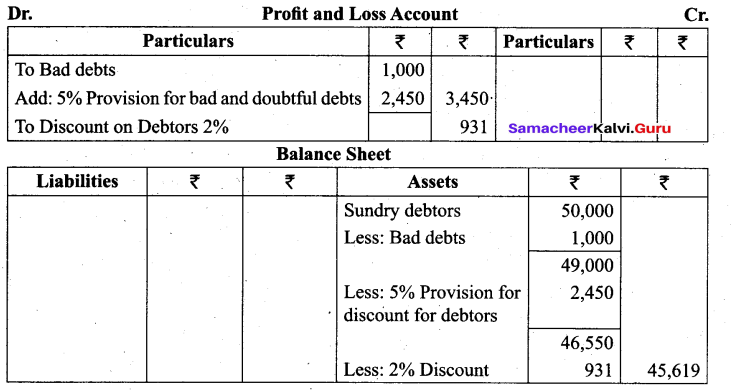
Question 33.
Prepare Trading account in the books of Mr. Sanjay for the year ended 31st December 2017.

Answer:

Question 34.
Classify the following expenditures and receipts:
1. Amount received from trade receivable during the year.
2. Amount spent on demolition of buildings to construct a large building on the same site.
3. Insurance claim received on account of a machinery damaged by fire.
Answer:
1. Revenue receipt
2. Capital expenditure
3. Capital receipts
Question 35.
Calculate the rate of depreciation under straight line method.
Purchase price of a machine ₹ 80,000.
Expenses to be capitalised ₹ 20,000.
Estimated realised value ₹ 4,000.
Expected useful life 4 years.
Answer:
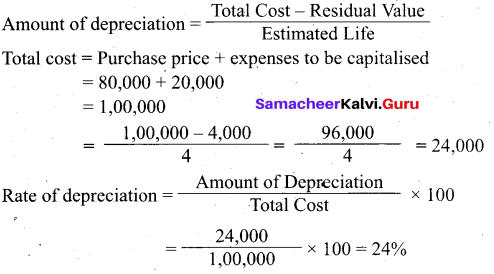
Question 36.
From the following particulars of Veera traders, prepare a bank reconciliation statement as on 31st December, 2017.
(a) Credit balance as per bank statement ₹ 6,000.
(b) Amount received by bank through NEFT for ₹ 3,500, entered twice in the cash book.
(c) Cheque dishonoured amounting to ₹ 2,500, not entered in cash book.
Answer:

Question 37.
Prepare furniture account from the following transactions.

Answer:

Question 38.
Journalise the following transactions:

Answer:
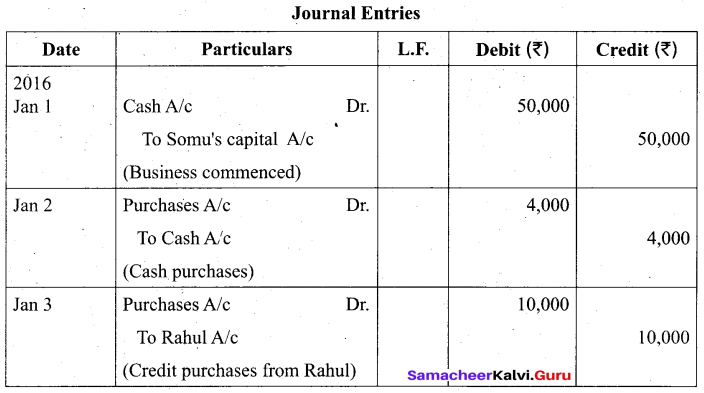
Question 39.
Enter the following transactions in a single column cash book of Seshadri for May, 2017
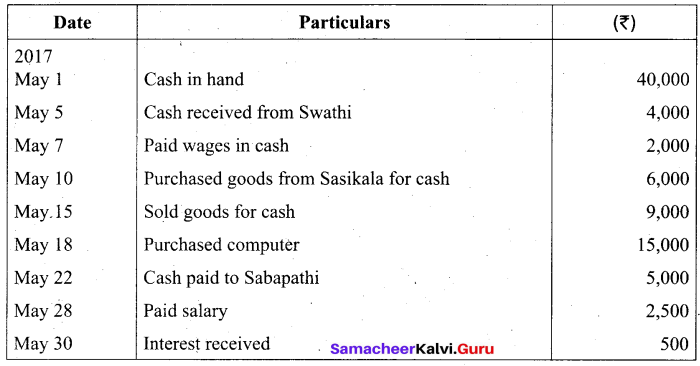
Answer:
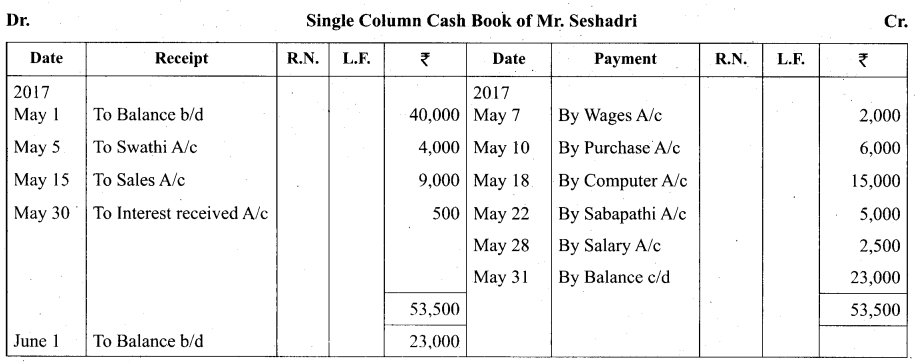
Question 40.
Prepare the trial balance from the following balance of Mr. Chandramohan as on 31st March, 2017.

Answer:
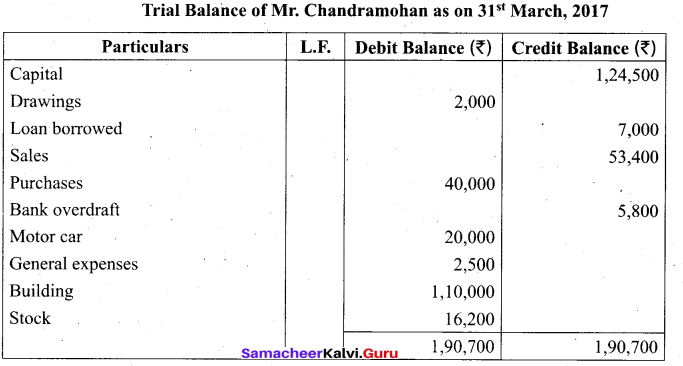
Part – IV
Answer all the questions: [7 × 5 = 35]
Question 41.
(a) What are the need for accounting standards?
Answer:
The need for accounting standards is as follows:
- To promote better understanding of financial statements.
- To help accountants to follow uniform procedures and practices.
- To facilitate meaningful comparison of financial statements of two or more statements.
- To enhance reliability of financial statements.
- To meet the legal requirements effectively.
[OR]
(b) Valluvar is a sole trader dealing in textiles. From the following transactions, pass journal entries for the month of March, 2018.
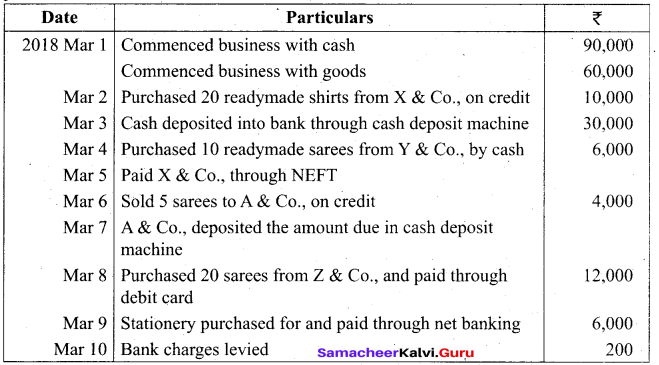
Answer:
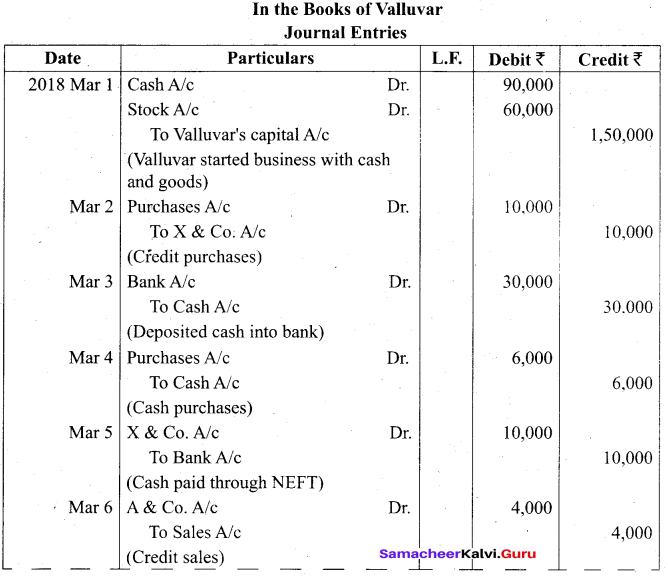
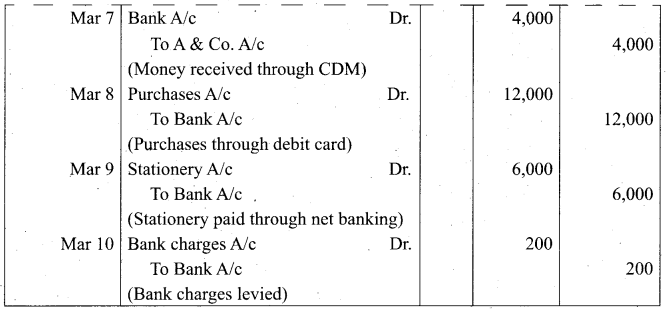
Question 42.
(a) Journalise the following transactions and prepare ledger accounts:

Answer:
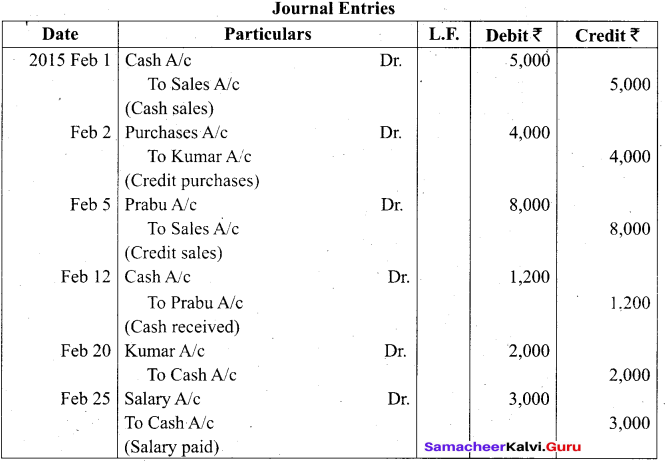
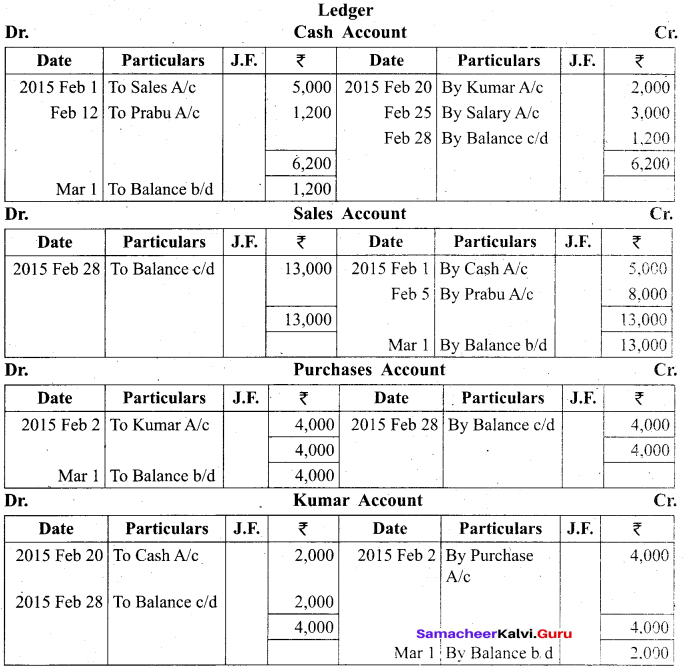
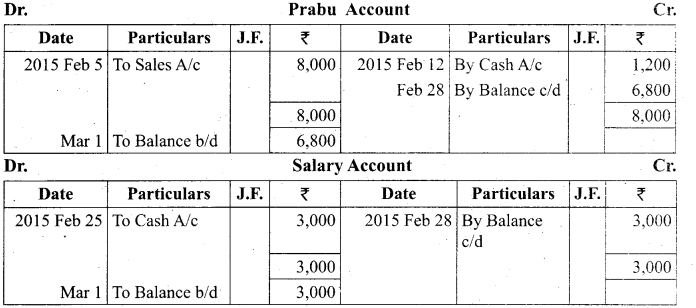
[OR]
(b) Correct the following trial balance:
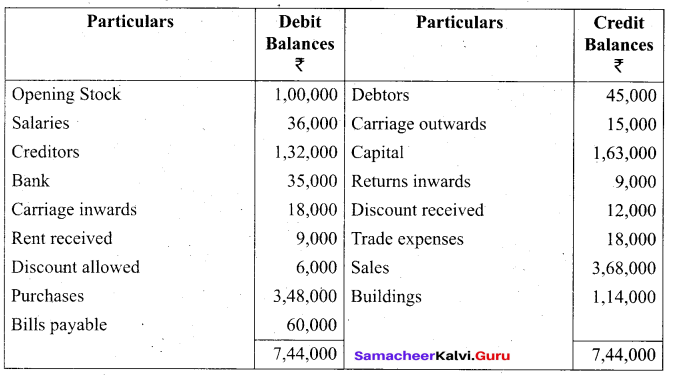
Answer:
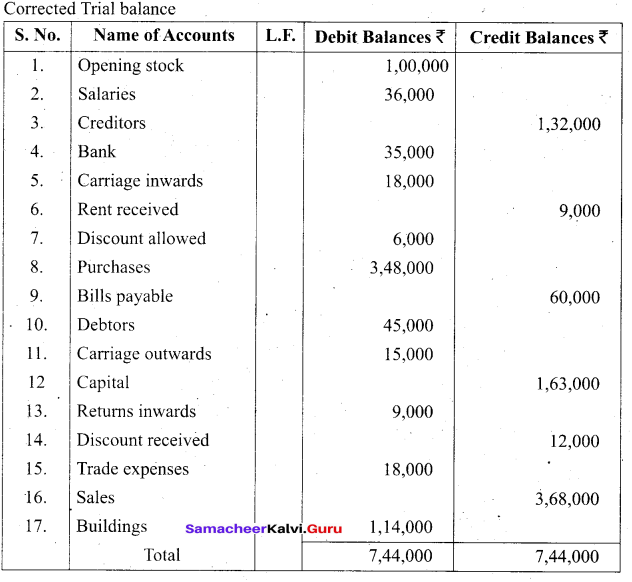
Question 43.
(a) Enter the following transactions in the Purchases book of M/s. Subhashree Electric Co., which deals in electric goods.
| Date | Particulars |
| 2017April 5 | Purchased from Karthik Electric Co., on credit 10 electric iron box @ ₹ 2,500 each 5 electric stoves @ ₹ 2,000 each |
| April 19 | Purchased on credit from Khaitan Electric Co., 3 electric heaters @ ₹ 6,000 each |
| April 25 | Purchased from Polar Electric Co., on credit 10 fans @ ₹ 2,000 each |
| April 29 | Purchased from M/s Co., on credit 10 electric stoves @ ₹ 3,000 each |
Answer:
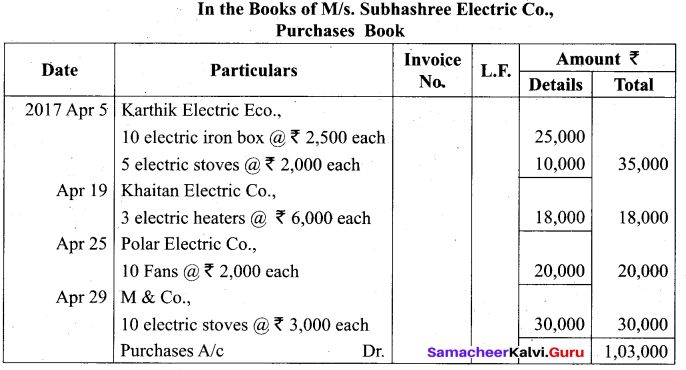
[OR]
(b) Enter the following transactions in a cash book with cash, bank and discount column of Sundari.
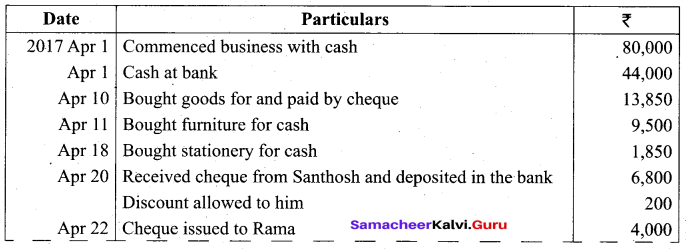

Answer:
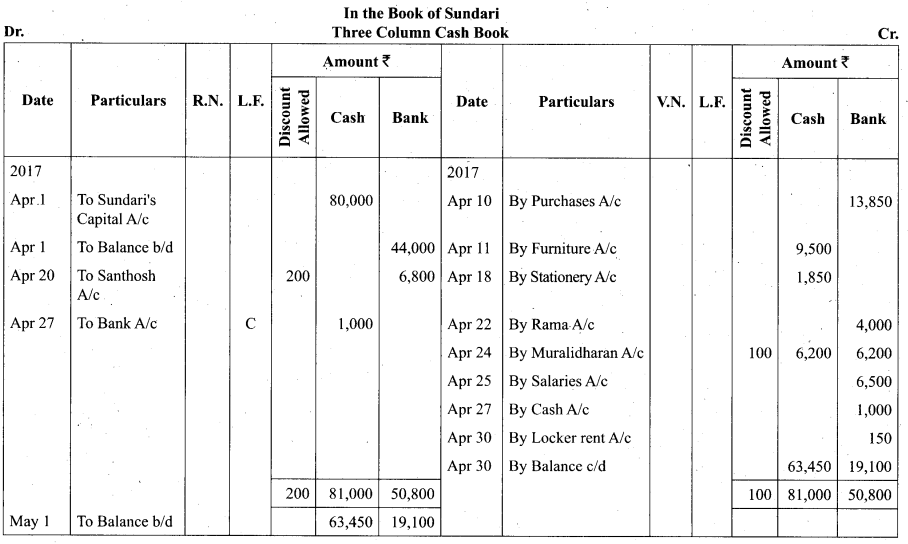
Question 44.
(a) Enter the following transactions in a single column cash book of Pandeeswari for the month of June, 2017.
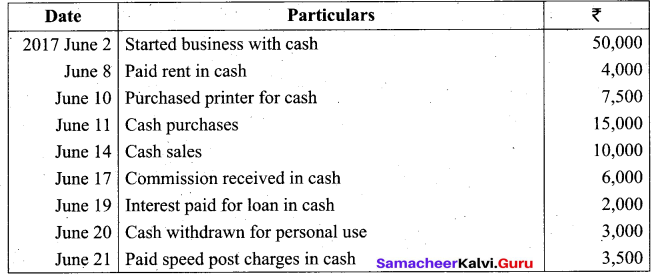
Answer:
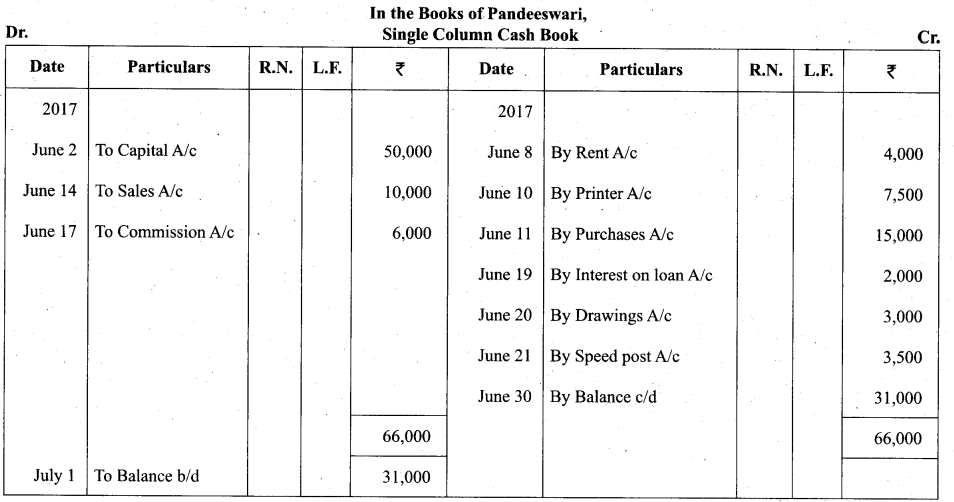
[OR]
(b) Enter the following transactions in Iyyappan’s Petty cash book with analytical ‘ columns under imprest system.
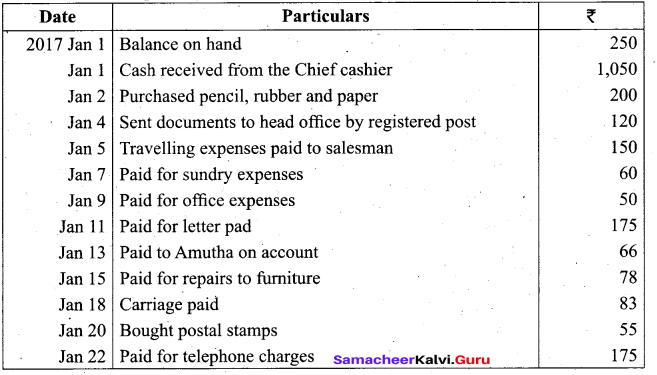
Answer:
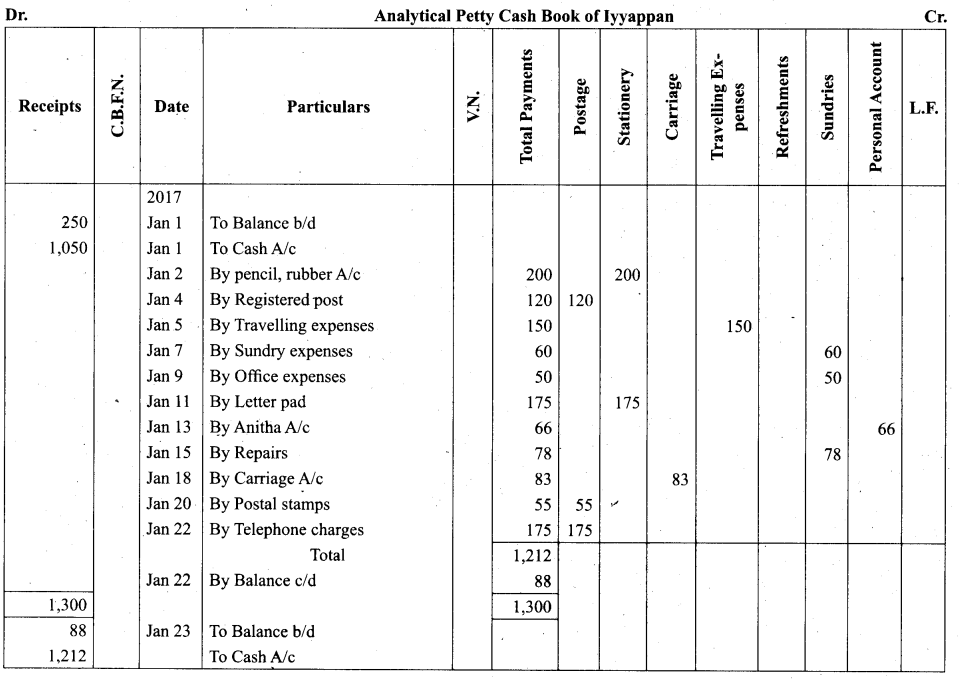
Question 45.
(a) On 31st March, 2017 Anand’s cash book showed a balance of ₹ 1,12,500. Prepare Bank Reconciliation Statement.
a. He had issued cheques amounting to ₹ 23,000 on 28.03.2017, of which cheques amounting to ₹ 9,000 have so far been presented for payment.
b. A cheque for ₹ 6,300 deposited into bank on 27.03.2017, but the bank credited the same only on 5th April 2017.
c. He had also received a cheque for ₹ 12,000 which, although entered by him in the cash book, was not deposited in the bank.
d. Wrong credit given by the bank on 30th March, 2017 for ₹ 2,000.
e. On 30th March, 2017, a bill already discounted with the bank for ₹ 3,000 was dishonoured, but no entry was made in the cash book.
f. Interest on debentures of ₹ 700 was received by the bank directly.
g. Cash sales of ₹ 4,000 wrongly entered in the bank column of the cash book.
Answer:
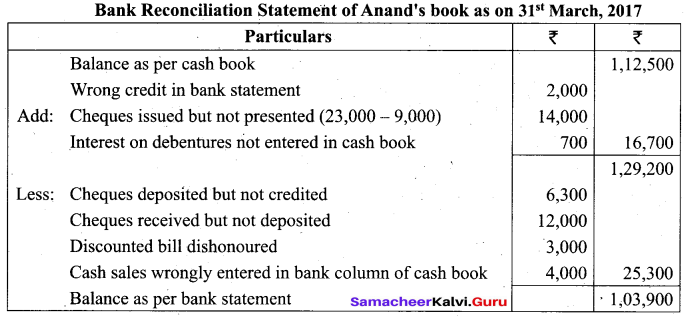
[OR]
(b) The following errors were located at the time of preparation of the trial balance. Rectify them.
a. Sale of goods to Akila on credit for ₹ 1,520 posted to her account as ₹ 1,250.
b. Bought goods from Narendran on credit for ₹ 5,500, credited to his account as ? 5,050.
c. Purchase of furniture from Ravivarman for ₹ 404 on credit were debited to furniture account as ₹ 440.
d. Purchased machinery for cash ₹ 2,000 was not posted to machinery account.
e. The total of purchase book ₹ 899 was carried forward as ₹ 989.
Answer:
a. Akila account should be debited with ₹ 270.
b. Narendran account should be credited with ₹ 450.
c. Furniture account should be credited with ₹ 36.
d. Machinery account should be debited with ₹ 2,000.
e. Purchases account should be credited with ₹ 90.
Question 46.
(a) Raj & Co., purchased a machine on 1st January 2014 for 90,000. On 1st July 2014, they purchased another machine for ₹ 60,000. On 1st January 2015, they sold the machine purchased on 1st January 2014 for ₹ 40, 000. It was decided that the machine be depreciated at 10% per annum on diminishing balance method. Accounts are closed on 31st December every year. Show the machinery account for the years 2014 and 2015.
Answer:
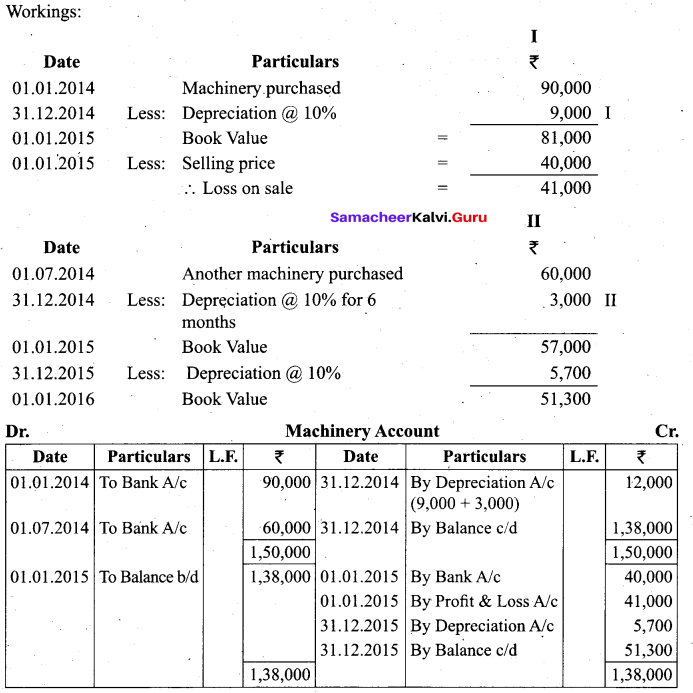
[OR]
(b) Identify the following items into capital or revenue.
i. Audit fees paid ₹ 10,000.
ii. Labour welfare expenses ₹ 5,000.
iii. ₹ 2,000 paid for servicing the company vehicle.
iv. Repair to furniture purchased second hand ₹ 3,000.
v. Rent paid for the factory ₹ 12,000.
Answer:
i.Revenue
ii.Revenue
iii.Revenue
iv. Capital
v. Revenue
Question 47.
(a) From the following information, prepare trading account for the year ending 31st December, 2017.

Answer:
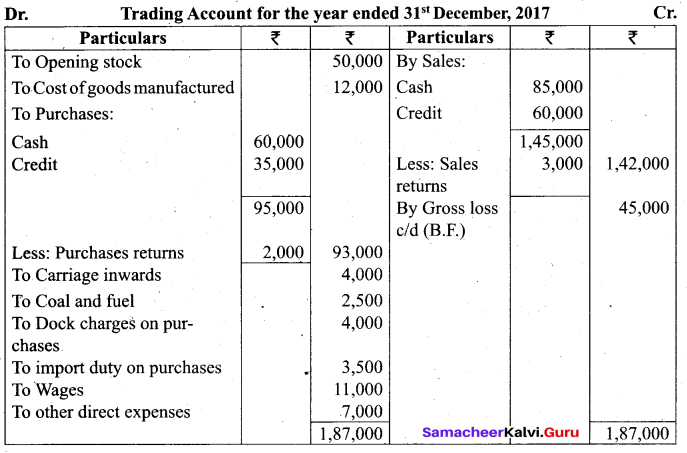
[OR]
(b) From the following particulars presented by Thilak for the year ended 31st March,
2017, prepare Profit and Loss account.

Adjustments:
a. Outstanding salaries amounted to ₹ 4,000.
b. Rent paid for 11 months.
c. Interest due but not received amounted to ₹ 2,000.
d. Prepaid insurance amounted to ₹ 2,000.
e. Depreciate buildings by 10%.
f. Further bad debts amounted to ₹ 3,000 and make a provision for bad debts @ 5% on sundry debtors.
g. Commission received in advance amounted to ₹ 2,000.
Answer:
Working note:


